8
People and plants
Our dependence on plants is absolute. They have shaped and defined the world we live in, and will always be essential for our very survival.
By capturing the energy of the sun through photosynthesis, plants are at the heart of the major cycles that created and sustain the biosphere. Not only are they the base of almost all food chains, they also provide essential ecosystem services: mediating the water cycle and the balance of gases in the atmosphere, making this a world in which we and other animals can live.
From the beginning, our species has selectively exploited the vast diversity of plants to meet our daily needs and as a source of inspiration in art and gardens. In our relationship with plants we have often changed them, shaping their morphology and biochemistry to our ends. At first this was a slow process, reflecting the harvesting and selection of seeds yielding the largest and most nutritious crops. Today, we have powerful techniques for selecting and introducing valuable traits into plants, to meet growing requirements for food. However, the demands on nature made by our burgeoning global population threaten the diversity of plants, and many cultivated plants and wild species are threatened with extinction. The race is now on to protect plant diversity, our life-support system.
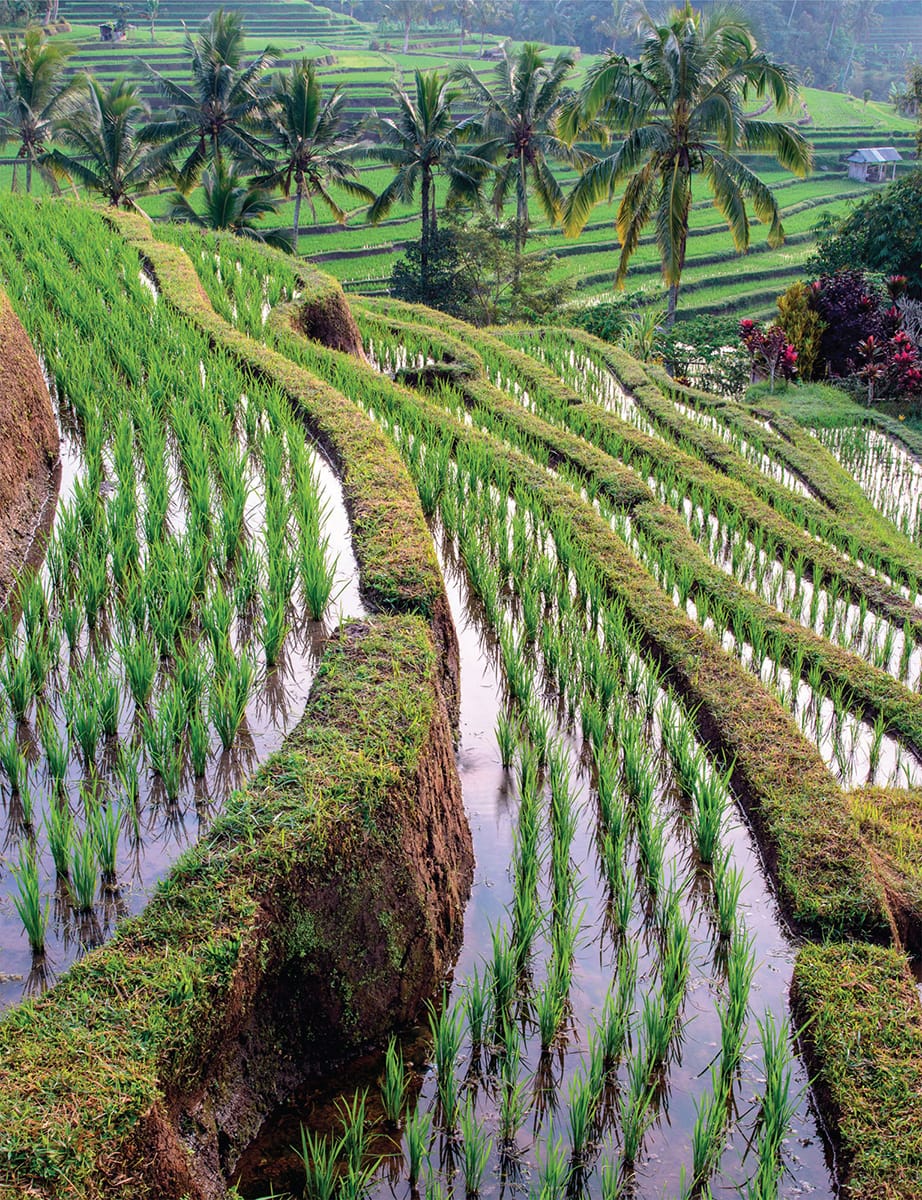
Cultural connections
The ancestors of modern humans relied heavily on plants in their diet, but our species has taken the relationship with them even further. Since the earliest times, people have shown remarkable inventiveness, finding uses for a multitude of plants. All parts of a plant, from above or below ground, have been evaluated and appropriated to meet our needs.
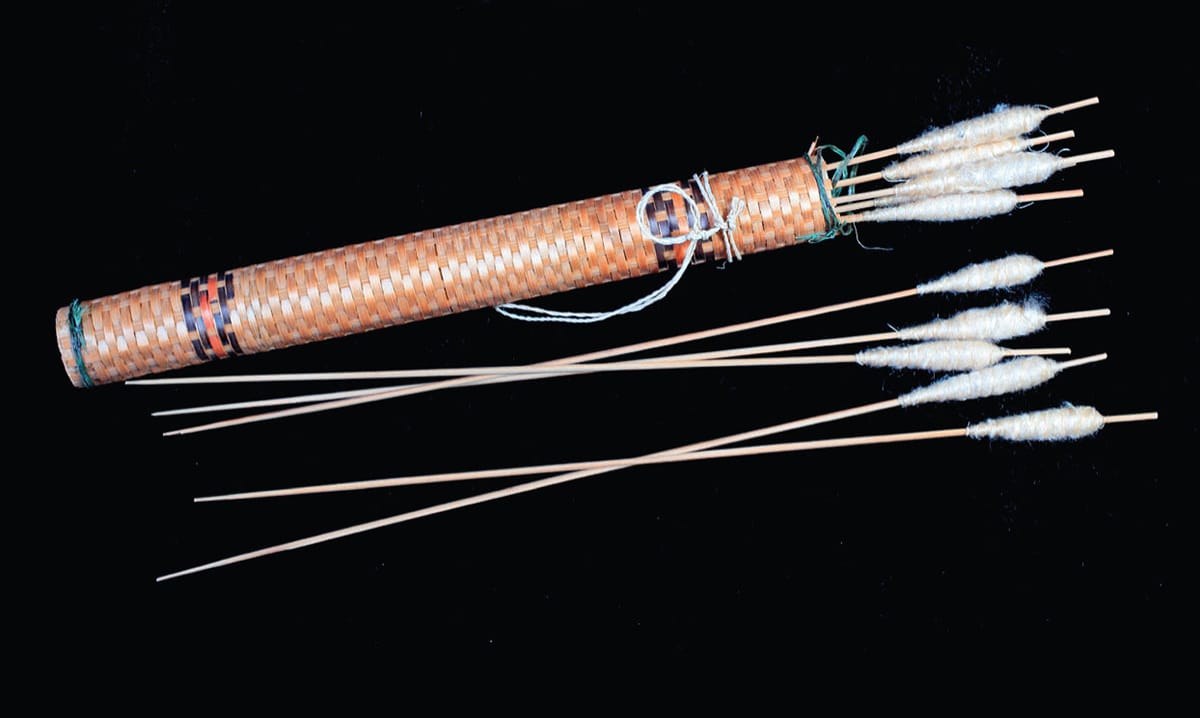
Plants for hunting: a woven quiver and cane blowpipe darts for use with curare, an alkaloid plant toxin. Made by Pemon indigenous people in Venezuela.
Survival skills
The ability to find and recognize many kinds of plants was once an essential skill for survival. Humans rely mainly on visual cues to distinguish between plants, identifying them by their morphology, although our senses of smell and taste also play important roles. As the properties and qualities of different plants were recognized, they became central to human life and powerful cultural connections were established. Knowledge of the growth of plants through the seasons enabled people to migrate and disperse around the globe, where they encountered different floras as they occupied new lands. The highest priority would always have been to forage for edible plants, usually to fill out a diet of meat, fish and seafood obtained by hunting.
Through time, plants came to be used in every aspect of daily life. Wood was burnt for warmth and fires lit for cooking and defensive purposes. Later, we learnt how to make charcoal, still an important fuel in many countries. Branches and timber provided everything from temporary shelters to permanent dwellings of increasing sophistication. Leaves, from palms to rushes, provided thatch for roofs and gave shelter from the elements. The properties of distinct types of timber were exploited in the manufacture of tools, furniture, and household and decorative items.
Plants for everything
A wide variety of plant fibres proved useful for making threads and ropes. Some, such as cotton (from Gossypium spp.) and linen (from the common flax, Linum usitatissimum), could be spun and woven into fabrics. Clothing could also be fashioned from large leaves such as those of the Chusan palm (Trachycarpus fortunei) or from bark cloth, usually made from the beaten bark of figs (Ficus spp.) and their relatives. Since Neolithic times, pigments extracted from plants have been used to colour and decorate fabrics, while those from henna (Lawsonia inermis) and woad (Isatis tinctoria) were used to dye hair and skin.
Other plant extracts have been used a wide variety of beverages, medicines and drugs. The refreshing and mildly stimulating infusions made from leaves of the tea plant (Camellia sinensis) leaves and beans from coffee (Coffea spp.) are consumed by billions around the world. We use herbs and spices to preserve our food and to enhance its flavour. Fermentation of grains and grapes produce a great diversity of intoxicating beers and wines. Stronger drugs, such opiates from the opium poppy (Papaver somniferum) and psychoactive alkaloids from peyote (Lophophora williamsii), were traditionally used in ceremony, magic and divination. The power of plants as a source of poisons has also been known, and applied, since antiquity. Thousands of plant species are listed in the materia medica of cultures around the world, with at least 7,000 being used in Chinese traditional medicine alone.
Today, we usually buy the plant products we use and many would struggle to recognize the species from which they come. Although foraging for wild food is fashionable, few of us could survive if forced to rely on nature rather than retail. In an era of globalization, plants used for everything from dietary staples to traditional medicines are traded around the world, and demand often outstrips supply, especially for those harvested directly from the wild.
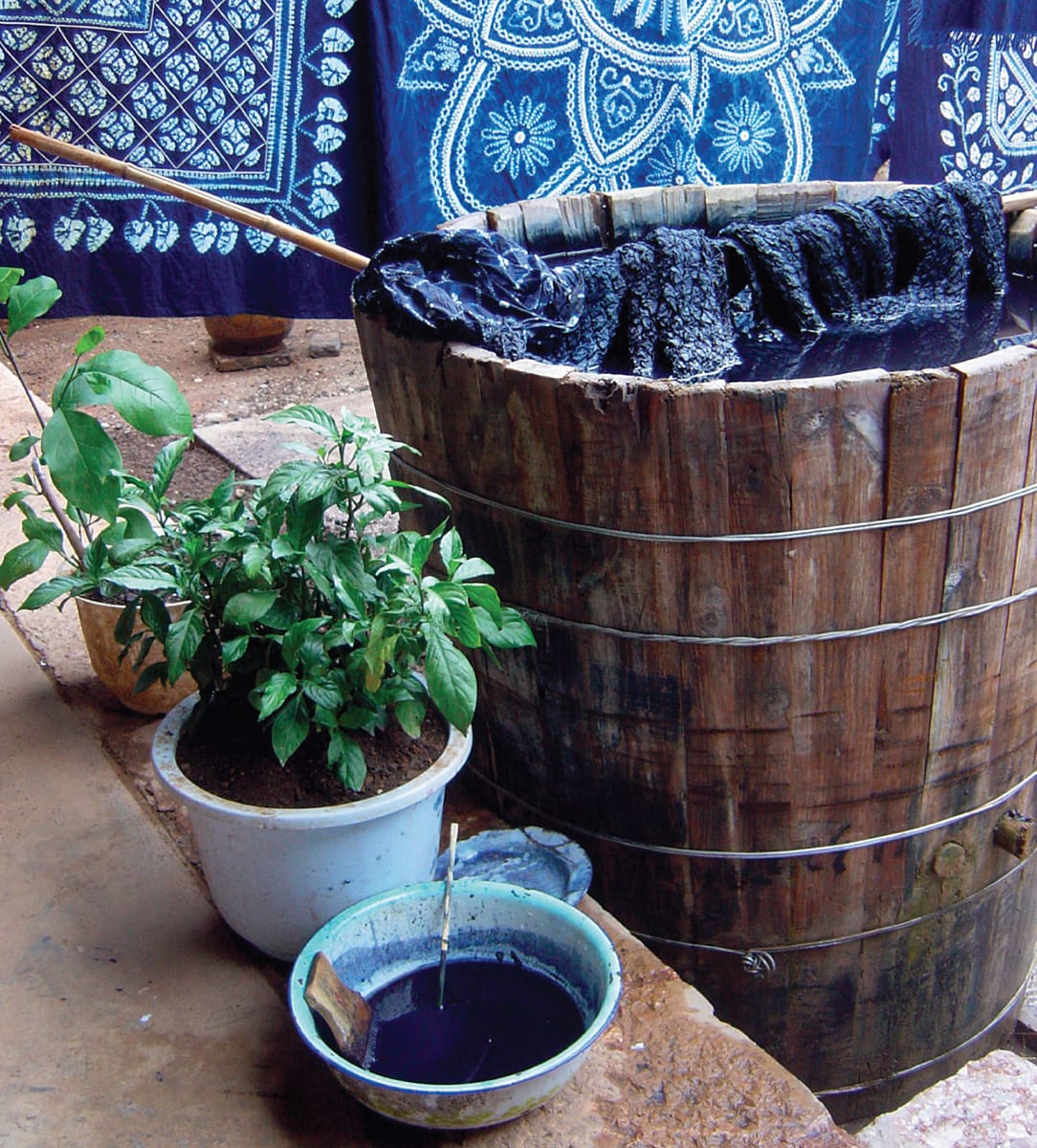
Deep blue indigo dyes are valuable and much sought-after plant products traditionally extracted from a wide variety of species. In China, the leaves of several species of Strobilanthes in the acanthus family (Acanthaceae) are used to dye fabrics.

Illustrated pages from an ancient Tibetan text, with instructions on the preparation and uses of traditional medicines extracted from plants of various kinds.
Ethnobotany
The study of traditional knowledge of plants is called ethnobotany. It is important for many reasons, not least as an important part of our cultural heritage and because our exploration of the plant kingdom is far from complete. Recognizing that most biodiversity-rich areas are inhabited by indigenous or local communities, Article 8 of the United Nations Convention on Biological Diversity emphasizes traditional knowledge, innovations and practices.

A Socotran man, with an encyclopaedic knowledge of the diversity and uses of the plants of the remarkable island he calls home, carefully harvests roots from a tree traditionally used as a medicine.
An oral tradition
As civilizations around the world acquired knowledge of plants, it became increasingly important to codify and communicate information, passing it from one generation to the next. Initially, this was an oral tradition, taught by elders to younger generations alongside the other skills they needed for survival. In many indigenous or aboriginal cultures, men and women maintained different traditions of plant use, passed on separately to sons and daughters. Common themes in such traditions were the need to know the morphology of plants, to recognize and differentiate between them, and to know their ecology, to understand when and where they could be found. The most expert practitioners possess knowledge extending into healing, divination, and spiritual and religious affairs, and are variously referred to as medicine men, shamans and witch doctors.

The botanical garden in Padua, Italy, established in 1545 for the cultivation and study of medicinal plants, provided a model that inspired the establishment of many other European physic gardens.
Recording plant wisdom
The invention of written languages allowed plant knowledge to be recorded and shared in ways that now provide powerful glimpses into the past. In ancient China, medicinal plant knowledge is traced back to 2700 BCE and the legendary Emperor Shen Nung, whose discoveries were documented in later writings. Clay tablets dating from seventh-century BCE Assyria recorded the use of more than 250 plant drugs, many of which are familiar today. Western traditions of plant medicine have their roots in ancient Greece and such works as Historia Plantarum and De Causis Plantarum by Theophrastus of Eresos, and De Materia Medica by Dioscorides. The latter was to influence many of the later herbals that followed the invention of the printing press in the fifteenth century, perhaps the best known of which is John Gerarde’s Herball of 1597.
Although western and Chinese medicine may seem worlds apart today, the early literature shows very similar emphasis on, for example, the ‘hot’ or ‘cold’ properties of specific plants and on correcting imbalances in the body. Both traditions have versions of the doctrine of signatures, in which similarities between plants and parts of the body are interpreted as a sign of special curative properties. The roots of mandrake (Mandragora officinarum), for example, have hallucinogenic properties and their resemblance to human bodies has been associated with powerful magical properties.

The Badianus Codex, the earliest book on the medicinal plants of the New World, was written by the Aztec physician Martin de la Cruz and translated into Latin by Juan Badiano, another Aztec Indian, in 1552.
From physic garden to modern botany
It was the use of plants in physic, or medicine, that gave rise to the establishment of scientific botanic gardens in Europe. In 1447, Pope Nicholas V established a physic garden in the Vatican, and others soon followed in Pisa (1544), Padua (1545) and elsewhere in Europe. What began as gardens for the cultivation and study of medicinal plants gradually became centres of botanical science, examining the diversity and classification of plants in addition to their uses. In the modern era, the search for new medicines follows several different paths, from synthetic chemistry to natural product discovery, often guided by ethnobotany.
Domestication of plants
Between 15,000 and 10,000 years ago, and with a remarkable synchronicity around the world, agriculture began to develop in widely separated civilizations. There would have been strong parallels in each case, with people who gathered food from the wild storing some of the seed and using it to sow a new crop close to home. Keeping seeds of the best-performing, most edible and nutritious crops introduced selection, shaping plants to meet human needs. An agricultural way of life enabled significant population increases, leading to larger settlements and, ultimately, the first cities.
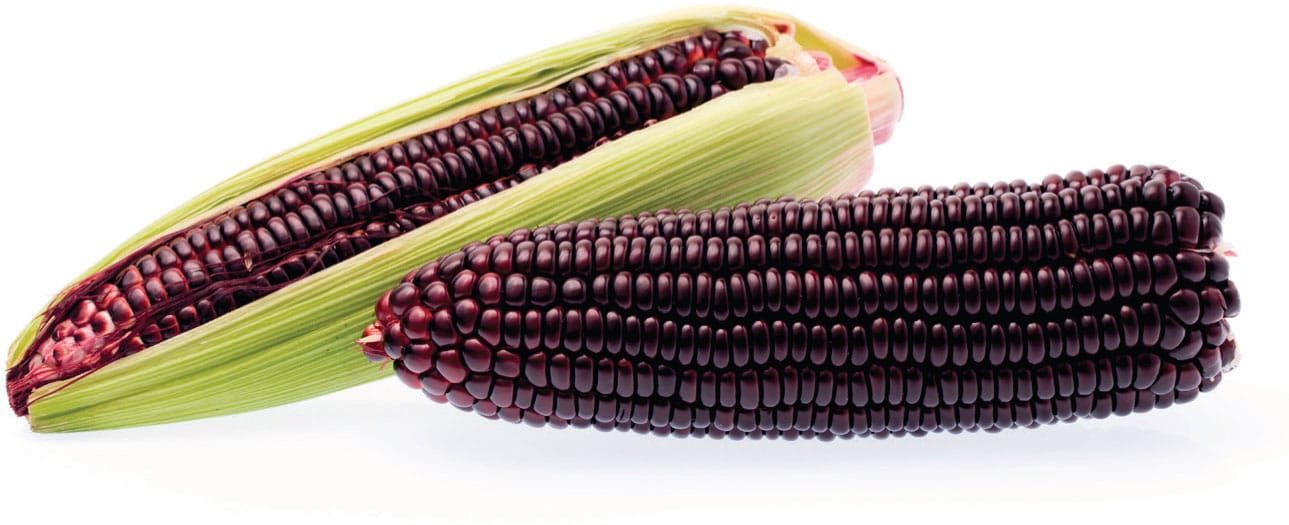
Purple maize (Zea mays ssp. indurata), rich in anthocyanin pigments, is an ancient Meso-American variety of what is now the world’s most productive crop.
Early crops – cereals
Our understanding of the origins of domestication was originally dependent on finding the archaeological remains of ancient crops, or graphical representations of their cultivation. More recently, however, greater precision has come from the ability to analyze the genome for DNA markers. This has revealed, for example, that the cultivation of rice (Oryza sativa) in Asia began about 13,500 years ago with the domestication of wild rice (O. rufipogon) in the Pearl River valley region of China. Soon afterwards, around 10,000 years ago, wheat (Triticum spp.) and barley (Hordeum spp.) cultivation began in the Fertile Crescent of the Middle East (see here). Meanwhile, around the same time in southern Mexico, selection of the most edible forms of a wild grass called teosinte (Zea mays ssp. parviglumis) gave rise to maize (Z. mays ssp. mays), the most important grain to have originated in the new world (see box). The common feature of these critical steps in human history is that the crops were cereals, annual grasses with nutritious grains, capable of being dried and stored. Cereals are named after Ceres, the Roman goddess of agriculture, and many distinct species are consumed. Those of African origin include sorghum (Sorghum bicolor), fonio (Digitaria spp.) and teff (Eragrostis tef) from the Ethiopian highlands. More familiar, and more widely traded, are barley (H. vulgare), oats (Avena sativa), sugar cane (Saccharum spp.) and rye (Secale cereale). However, it is maize, rice and wheat that are the staple foods for much of humanity.

An ancient Egyptian stone carving from the Temple of Horus at Edfu depicts a priest carrying stalks of wheat (Triticum sp.), demonstrating the long-standing importance of this crop.
Rank |
Crop |
World production 2012 (tonnes) |
Average world yield 2010 (tonnes per hectare) |
World’s most productive countries 2012 (tonnes per hectare) |
World’s largest producing countries 2013 (tonnes) |
1 |
Maize (corn) |
873 million |
5.1 |
United States (25.9) |
United States (354 million) |
2 |
Rice |
738 million |
4.3 |
Egypt(9.5) |
China (204 million) |
3 |
Wheat |
671 million |
3.1 |
New Zealand (8.9) |
China (122 million) |
4 |
Potatoes |
365 million |
17.2 |
Netherlands (45.4) |
China (96 million) |
5 |
Cassava |
269 million |
12.5 |
India (34.8) |
Nigeria (47 million) |
6 |
Soya beans |
241 million |
2.4 |
Egypt (4.4) |
United States (91 million) |
7 |
Sweet potatoes |
108 million |
13.5 |
Senegal (33.3) |
China (71 million) |
8 |
Yams |
59.5 million |
10.5 |
Colombia (28.3) |
Nigeria (36 million) |
9 |
Sorghum |
57.0 million |
1.5 |
United States (86.7) |
United States (10 million) |
10 |
Plantain |
37.2 million |
6.3 |
El Salvador (31.1) |
Uganda (9 million) |
Ten staples that feed the world (by annual production).
Root crops
Cereal crops are highly nutritious because their dry, one-seeded fruits contain the endosperm, provided to nourish the developing embryo, but the characteristics of other plant organs also make them highly suitable for cultivation. The underground parts of many plants, whether roots, rhizomes or tubers, are adapted as storage organs for carbohydrates, and as such they are potentially important as highly calorific crops. In the tropics, root vegetables such as taro (Colocasia esculenta) corms, and yam (Dioscorea spp.) and cassava (Manihot esculenta) tubers, are often more important than cereals. Because they contain toxins intended to reduce predation by animals, all three root crops – and many others – require careful preparation before they are edible. As with cereals, selective breeding has led to the development of thousands of selected lines, known as landraces, maintained and handed on within communities.

The starchy tubers of cassava (Manihot esculenta), native to South America, are widely grown in the tropics. The plant thrives on low rainfall and in poor soils unsuitable for growing more nutritious crops.
An underground bounty
Most of the underground plant organs we use derive from roots and underground shoots, an exception being the peanut or groundnut (Arachis hypogaea), a legume that develops underground seedpods. In the life of a plant, most underground organs store energy, in the form of carbohydrates, or water. If edible, they are useful sources of dietary calories, but are usually low in proteins and other nutrients. In addition to true roots, a wide variety of bulbs, corms, rhizomes and tubers are cultivated.
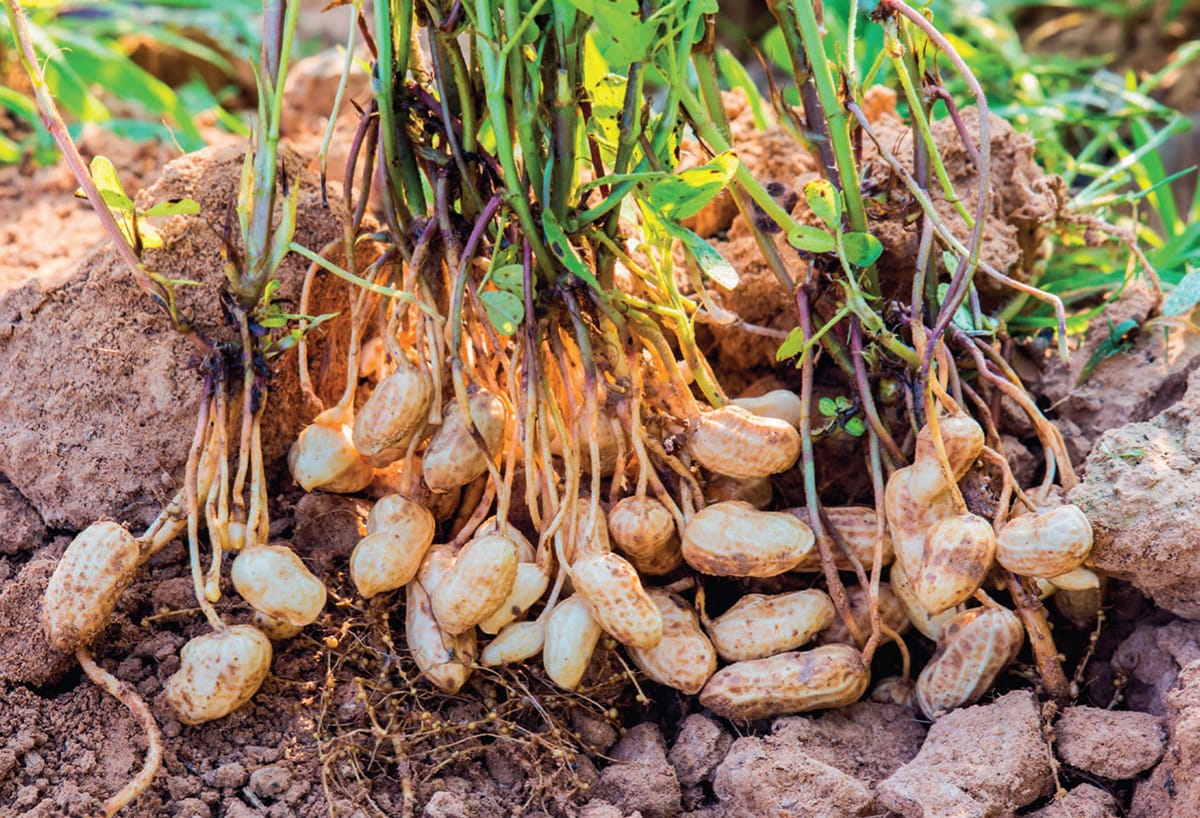
Peanuts (Arachis hypogea) ready for harvesting. The yellow flowers, like those of other legumes, are borne above ground, but after fertilization the ovary stalk becomes greatly elongated, forming a ‘peg’ that pushes the developing pods underground.
Bulbs and corms
Bulbs are almost exclusively found in monocotyledons, and consist of fleshy leaf bases growing from a compressed and very reduced stem. Being underground leaves, they do not carry out photosynthesis and, lacking chloroplasts, are never green. Many familiar ornamental garden flowers are grown from bulbs, including daffodils (Narcissus spp.) and tulips (Tulipa spp.). The most widely used edible bulbs belong to the mainly northern hemisphere genus Allium, which includes onions (A. cepa), garlic (A. sativum) and chives (A. schoenoprasum). These have been cultivated for more than 5,000 years and are valued in cooking for their pungent taste – from chemical compounds intended to deter herbivores – and, to a lesser extent, in medicine.
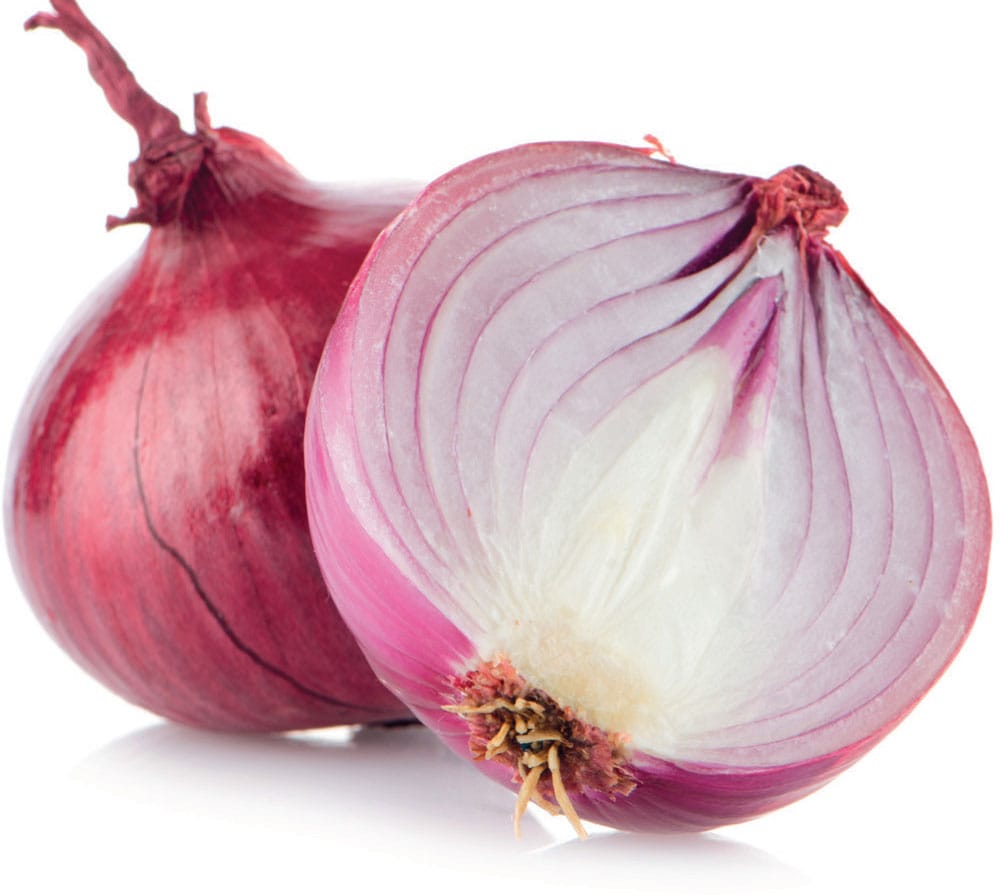
Red onions (Allium cepa cultivars) have been selected for their mild, sweet flavour. When the bulb is sliced in half, its overlapping fleshy leaf bases are clearly visible.
Corms are short, swollen stems, usually surrounded by protective dried petioles, or leaf bases. When cut open, a solid mass of tissue comprising parenchyma cells rich in stored starch is exposed. Two species in the arum family (Araceae) that are widely cultivated for their nutritional corms are taro (Colocasia esculenta), originally from India and Southeast Asia, and eddoe (C. antiquorum), from China. Sometimes considered a single species, these important tropical crops were carried by the original settlers of Hawai’i and Polynesia. The cells of their corms contain needle-shaped raphides, crystals of calcium oxalate, which if eaten without careful preparation damage the tissues of the mouth and throat, making swallowing difficult. Soaking in cold water partially removes the crystals, and cooking turns the corms into a starchy mass, making them less harmful.
Rhizomes and tubers
Rhizomes are also underground stems. They have extended horizontal growth, with shoots and roots emerging at the nodes. Most can readily be cut into pieces and used for vegetative propagation. The edible rhizome of the sacred lotus (Nelumbo nucifera) grows in the soil of shallow ponds and contains numerous air-filled cylindrical channels. Rhizomes of members of the ginger family (Zingiberaceae), including turmeric (Curcuma longa) and ginger (Zingiber officinale), are widely used as spices in cooking and in traditional medicine.
A tuber is a specialized kind of rhizome or stolon. Much thickened in places, it acts both as underground storage and vegetative propagule, with the capacity to sprout new shoots and roots. The potato (Solanum tuberosum) is the most important tuberous crop, ranked fourth in its contribution to the global food supply. Its wild ancestor (a member of the S. brevicaule complex) was domesticated by the Inca people of South America between 5,000 and 8,000 years ago. There are now more than 5,000 varieties in cultivation, and breeding programmes draw upon genes from related species. Cassava, originally from Brazil, is ranked fifth in the global food supply, and is of immense importance in the tropics.
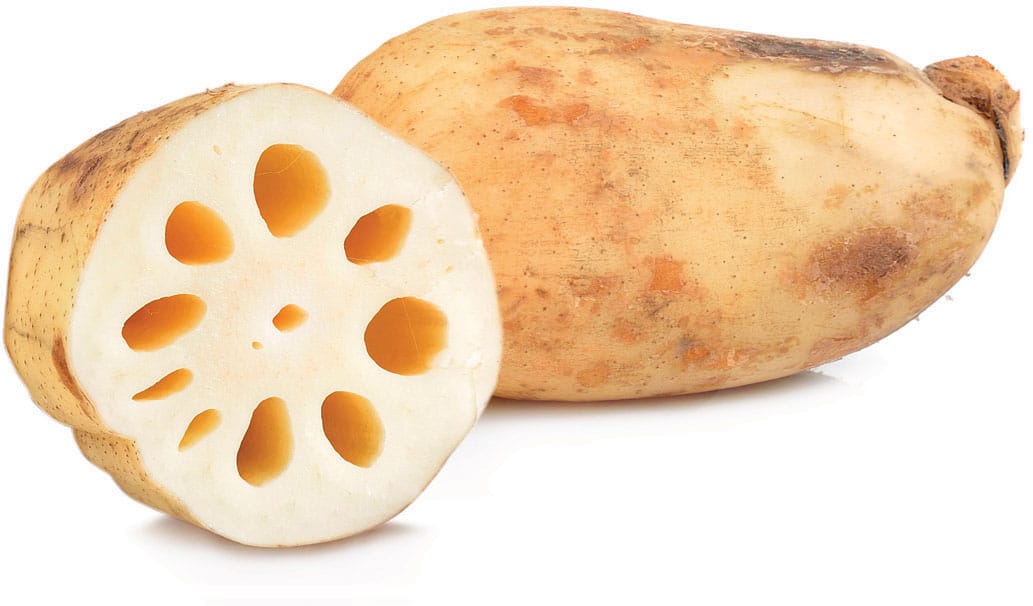
Lotus (Nelumbo nucifera) rhizomes have long, hollow channels that allow air to reach the submerged root system of the plant. A fast-growing and nutritious crop with many distinct varieties, the rhizomes are harvested by hand two to three months after planting.
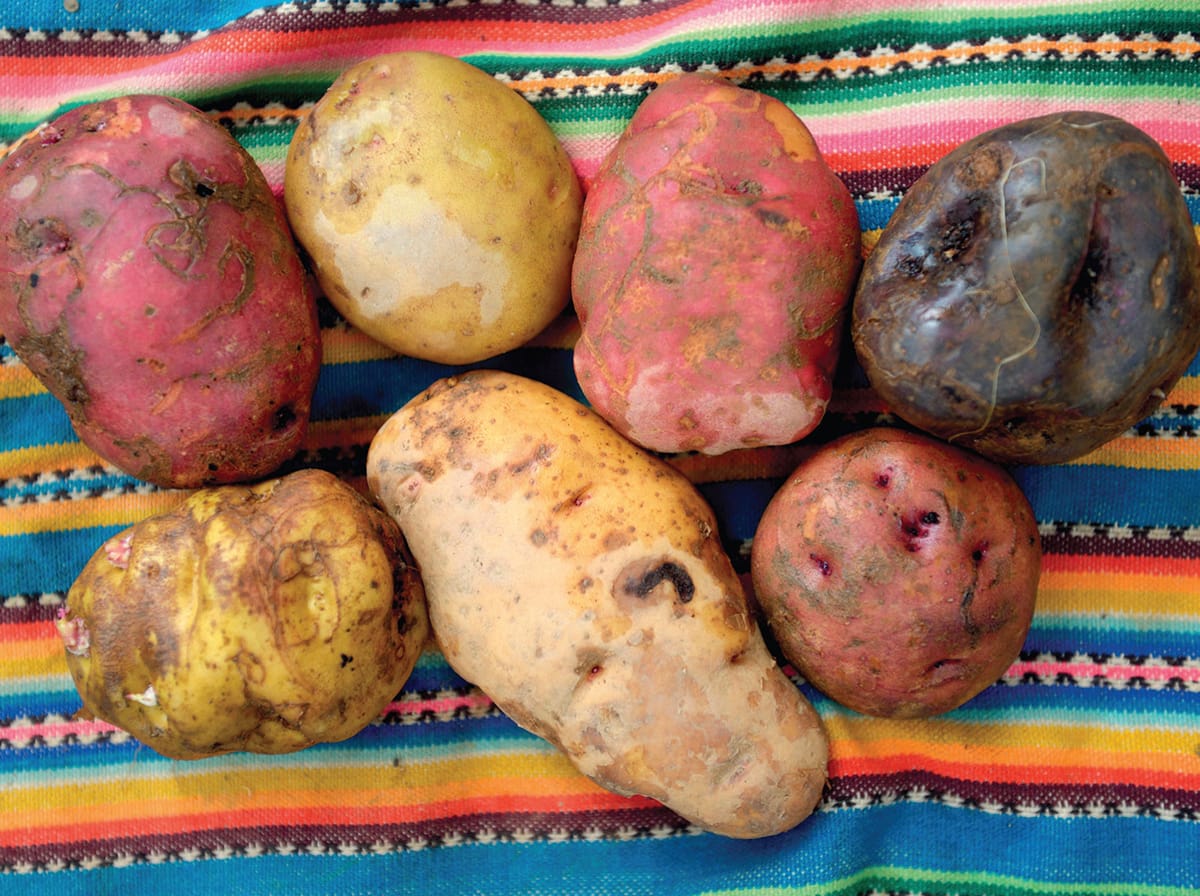
A colourful selection of traditional Andean potato (Solanum tuberosum) varieties cultivated by the Quechua people of Chuquis district in Huánuco province, Peru.
Useful roots
Roots, the primary underground organs of plants, provide a surprising diversity of useful products, from food and beverages to medicines and rubber. As is the case for underground stems, those we exploit are mainly adapted for the storage of energy and water. This enables the plant to survive in desert and high alpine habitats, where liquid water is scarce or it needs to regrow rapidly after being grazed by animals.

A pneumatic truck tyre manufactured by Continental from Taraxagum, a brand of latex produced from dandelion (Taraxacum sp.) roots and developed as a potentially sustainable alternative to conventional rubber (Hevea brasiliensis) by the Fraunhofer Institute for Molecular Biology and Applied Ecology in Germany.
What connects latex and coffee?
Making rubber from the latex of the Kazakh dandelion (Taraxacum kok-saghyz) root was initially a wartime response to shortages of supplies from rubber trees (Hevea brasilinesis). The latex is produced in specialized elongated cells called laticifers, which form a secretory system extending throughout the plant as a defence against herbivory. Aside from being characteristic of the Cichorieae tribe of the daisy family (Asteraceae), laticifers are found in several other families of flowering plants, including the spurges (Euphorbiaceae). Cichorieae also includes several species with useful tap roots. Chicory (Cichorium intybus) roots are roasted as an additive to, or substitute for, coffee, and dandelion (Taraxacum spp.) roots are less commonly used in the same way. Those of purple salsify (Tragopogon porrifolius) and black salsify (Scorzonera hispanica) can grow up to a metre (3 ft) long and are minor vegetable crops in Europe. All four of these tap roots contain the polysaccharide inulin, rather than starch, as a storage product, and this is extracted for use as soluble dietary fibre. Inulin gives the roots diuretic properties, widely exploited in traditional medicine around the world and reflected in common names such as pissenlit in France and piss-a-bed in England.
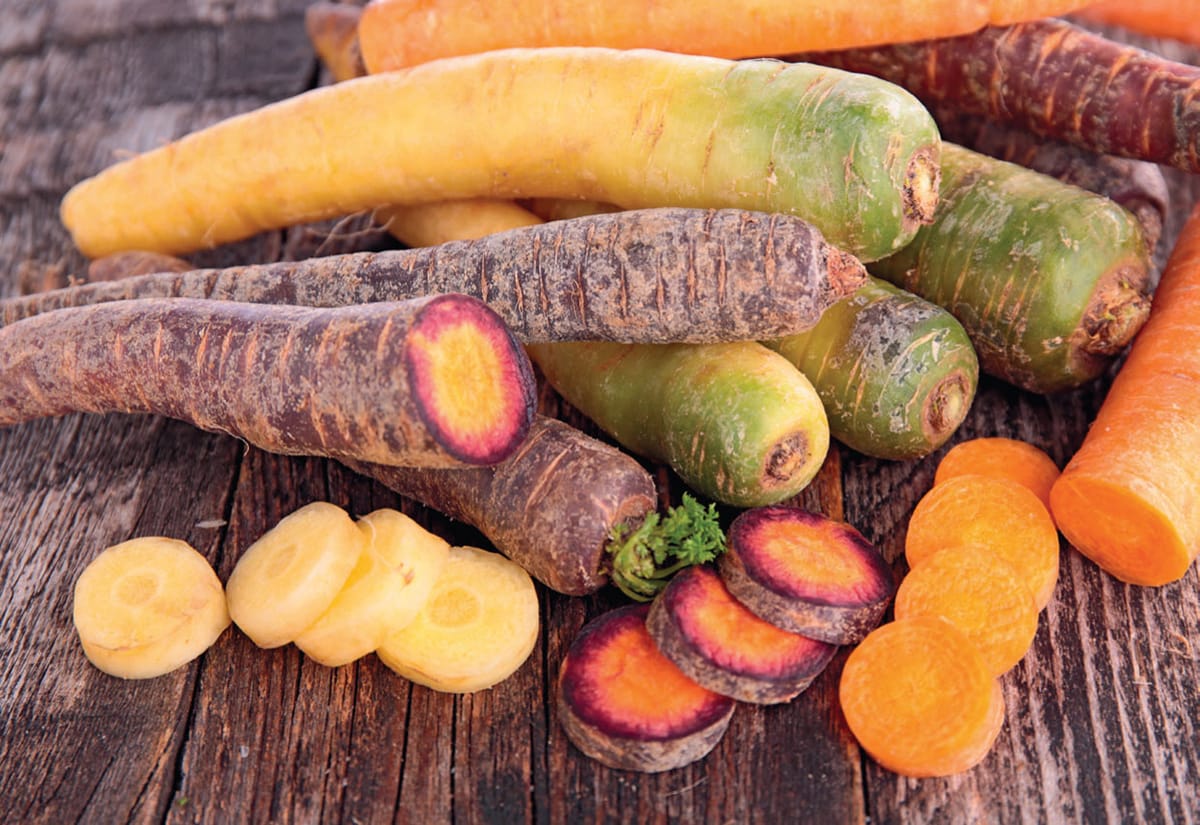
Although the most widely cultivated carrots (Daucus carota ssp. sativus) are the familiar orange colour, new varieties with many different pigments are becoming ever more popular.
Tasty tap roots
The carrot family (Apiaceae) is a large group of aromatic dicotyledons with flowers arranged in umbels. Most have large tap roots and although some, like the water dropworts (Oenanthe spp.), are extremely poisonous, others are among the most familiar vegetables. The carrot (Daucus carota ssp. sativus), whose tap root is not always orange but can be purple, red or yellow, was domesticated in central Asia and selectively bred for reduced woodiness and improved flavour. Different shapes and sizes have also been selected – shorter carrots can grow in heavy or rocky soils and be harvested early, while longer-rooted varieties are better suited to sandier soils and take more time to mature. The closely related parsnip (Pastinaca sativa) has a similar geographical origin; its root was historically used as a sweetener. Parsnips that have stayed in the ground over winter are sweetest, because more of the starch in the root has been converted to sugar.
Neat beets
Sea beet (Beta vulgaris spp. maritima), a widespread old world coastal member of the amaranth family (Amaranthaceae), is the wild ancestor from which five cultivar groups of crops have been developed. Most of the present-day diversity is the work of crop breeders from the eighteenth century onwards, a key element of which was the selection of a rare allele reducing sensitivity to day length and resulting in a biennial life cycle. The tap roots of sugar beet (B. vulgaris, Altissima group of cultivars) contain up to 20 per cent sugar by weight, making it a competitor, in cold temperate regions, to the tropical sugar cane. The dark red beetroot (B. vulgaris, Conditiva group of cultivars) is the most familiar culinary vegetable, while the field beet or mangelwurzel (B. vulgaris, Crassa group of cultivars) is an important fodder crop for livestock in temperate regions.
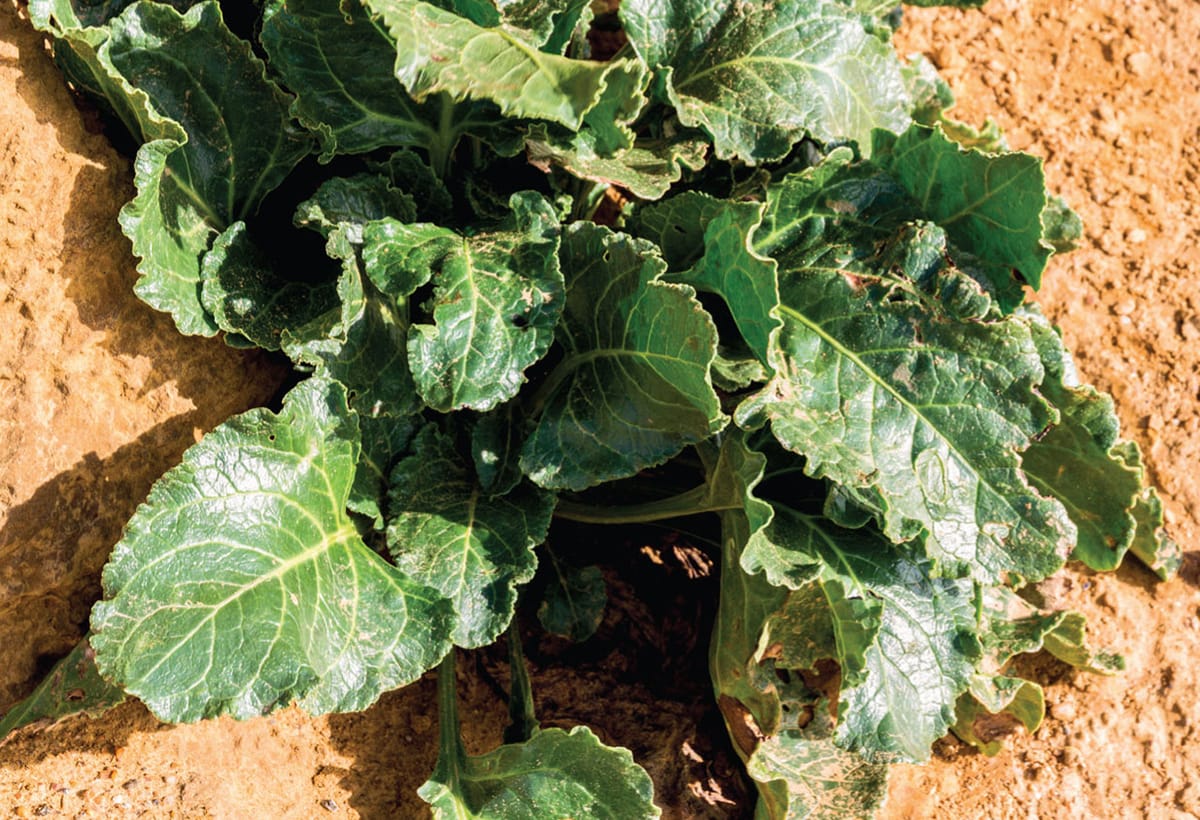
Sea beet (Beta vulgaris ssp. maritima), seen here growing wild on a sandstone cliff in the United Kingdom, is the wild species from which many different beet crops have been developed.
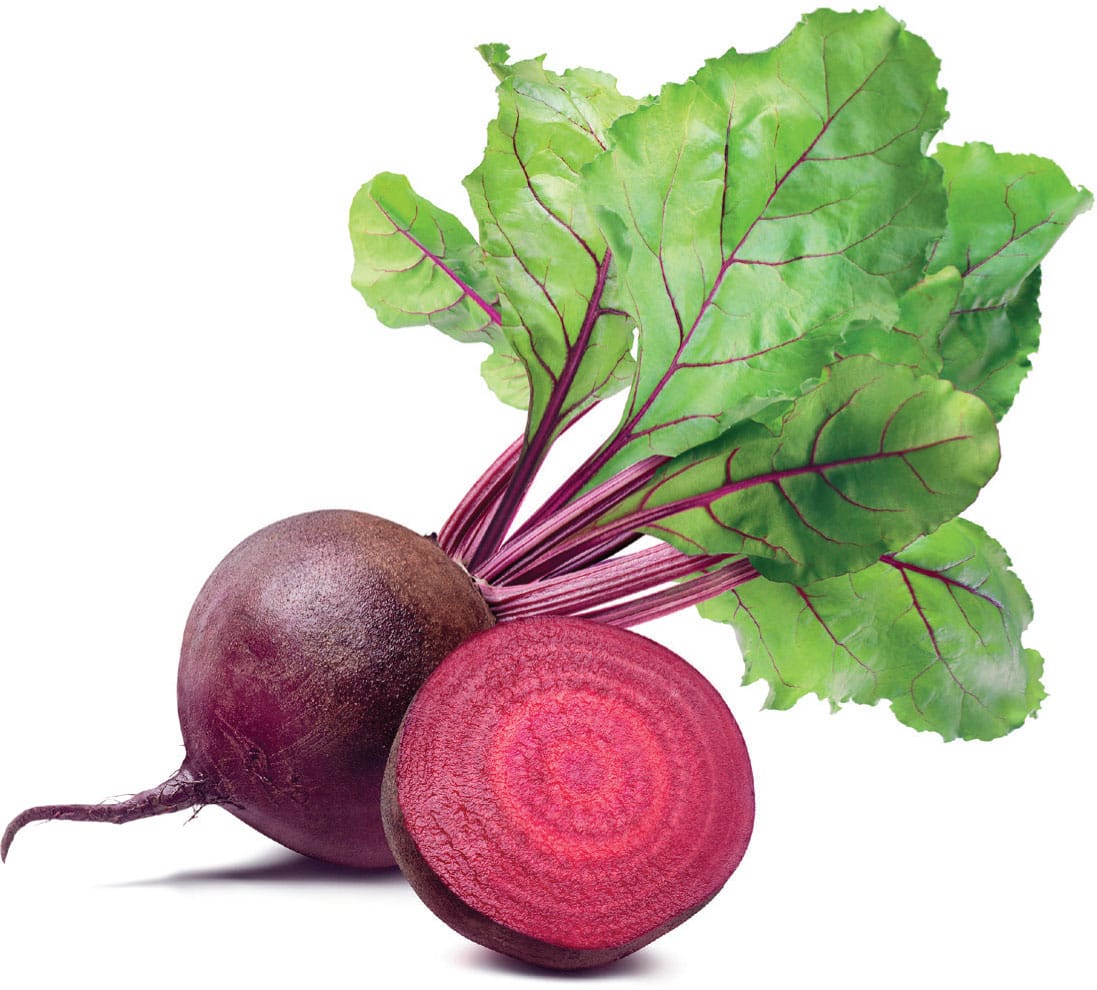
Beetroot (Beta vulgaris Conditiva group of cultivars) is primarily grown for its deep red taproots, although the leafy parts of the plant are also edible, resembling spinach.
Stems for bark and fibres
The strength and flexibility of stems aids the growth of plants towards the light, and humans have found uses for every part of them, from the outer epidermis to the wood within. The straight, flexible stems of many species lend themselves to specific applications. Archaeological evidence shows that at least 12,000 years ago, around the time people adopted an agricultural way of life, they wove baskets from the most suitable plants to hand and used species with thorny branches as living fences, to protect and enclose livestock.
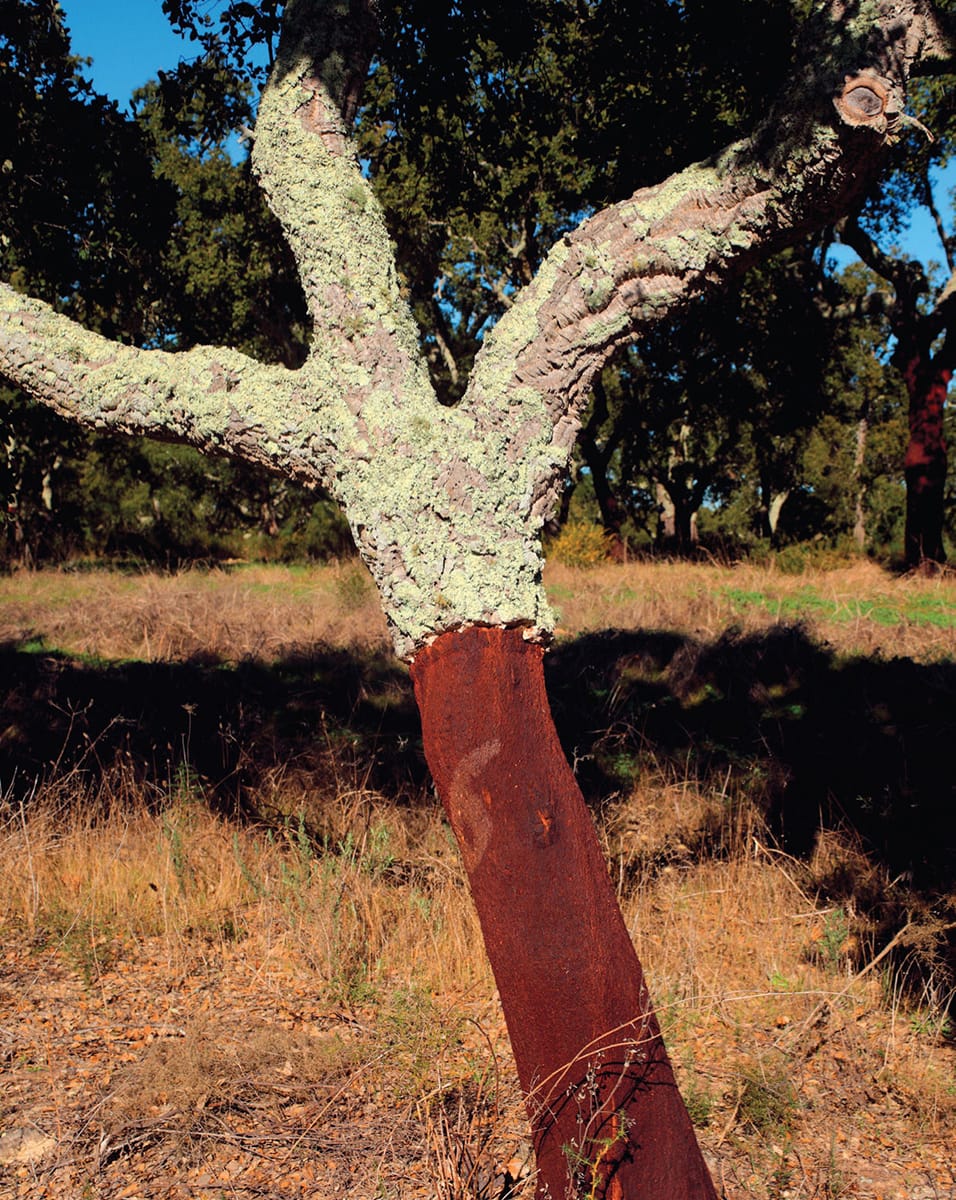
A cork oak (Quercus suber) growing in the Alentejo region of Portugal, soon after the outer bark has been cut and peeled away. A new layer of bark regrows and can be harvested in about ten years.
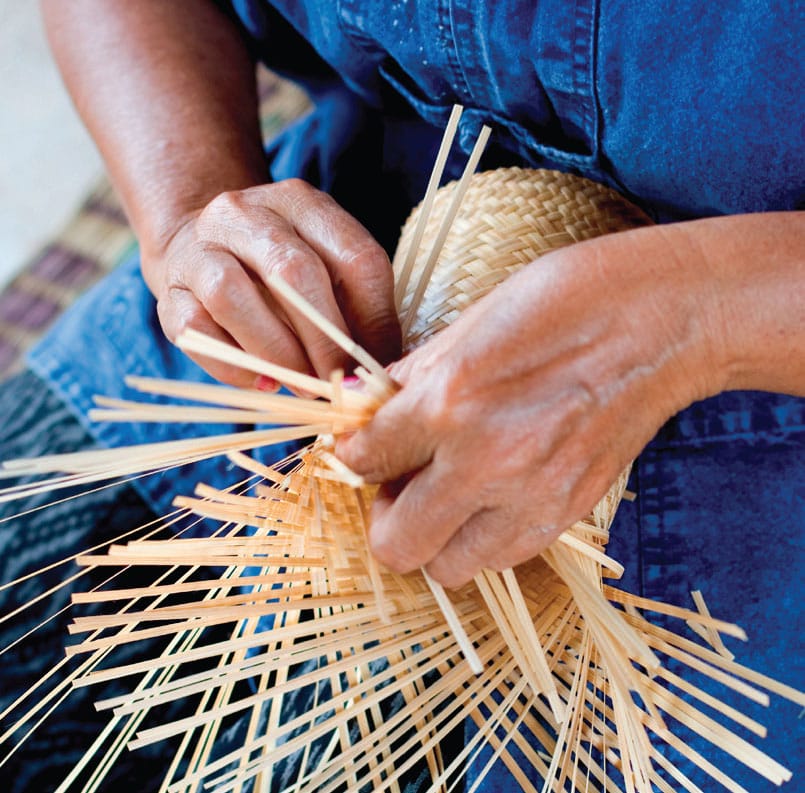
Basket weaving, using plants ranging from bamboo, to cane, palm and wood, is one of the oldest human crafts with different traditions developed on every continent.
Barking up the right tree
Bark forms a protective layer around trunks and branches that can enable trees to survive physical damage and fire. The thick bark of cork oak (Quercus suber), a tree of fire-prone Mediterranean habitats, can be harvested repeatedly every 12 to 15 years to make corks for bottling wine. The inner bark of cinnamon (Cinnamomum cassia and related species), obtained from coppiced branches, is harvested as a fragrant spice. The woody outer bark is discarded and the inner bark, which contains cinnamaldehyde, is dried and rolls into quills. One of the most familiar of all medicines, aspirin, was developed as a synthetic version of the naturally occurring salicylic acid, traditionally extracted from the bark of willow trees (Salix spp.). The medicinal use of willow bark for treating fevers was recorded by Dioscorides and earlier writers. Quinine, isolated from the bark of Cinchona species (especially C. officinalis) and used traditionally in South America for treating fevers, became highly coveted around the world as a cure for malaria. It also gives the bitter flavour to tonic water, which gained popularity in British India, where it was taken with gin to prevent malaria. Other chemicals found in bark have deadlier uses. The bark of the southern African ordeal tree (Erythrophleum suaveolens) contains a poison used on arrows for hunting and to determine guilt or innocence. If the accused died after drinking the bark extract, they were guilty; if they survived, they were innocent.
Functional fibres
Bast fibres, elongated cells that form a protective layer of inner bark outside the phloem, can be spun into yarn for rope making or weaving into fabric. The main sources are hemp (Cannabis sativa), jute (Corchorus capsularis and Corchorus olitorius), common flax and kenaf (Hibiscus cannabinus). The fibres are obtained through the process of retting, which involves keeping the harvested stems under water for several weeks. During this time, naturally occurring fungi break down the materials that bind cell walls together.

Hemp (Cannabis sativa) thread, rope and canvas spun from stem fibres are prized for their strength, durability and resistance to rotting.
Wood
Wood is one of the earliest materials to have been used by mankind. Today, we distinguish between softwoods, from conifers, and hardwoods, from angiosperms. However, the actual density of timber – a major factor in the uses to which it can be put – does not divide into these two convenient categories. Among the conifers, yews (Taxus spp.) yield hard timber, while in the flowering plants, the balsa tree (Ochroma pyramidale) produces timber lighter than cork.

The wood produced by different trees varies greatly in physical properties such as density and strength, and in wood grain, the pattern of alternating light and dark areas revealed in sawn and polished timber. When sawn longitudinally, many kinds of timber are figured rather than uniform, with different patterns being prized for such uses as musical instruments.
Softwoods
Softwoods make up more than 75 per cent of commercially traded timber and derive from a diversity of coniferous trees, which reflects their wide distribution, especially in boreal forests. Much of the timber from conifers is used in construction, providing key structural elements, especially in timber-framed buildings. Softwoods, especially those grown in plantations, are also widely used to make wood pulp and woodchips as raw material for the manufacture of paper, fibreboard and chipboard. The bark is discarded, but both the heartwood and sapwood can be used. Woodchips are also utilized as a renewable biofuel in heating or combined heat and power applications. In recent years, wood pulp has been used to make a new material, nanocrystalline cellulose (NCC), which has a strength-to-weight ratio eight times that of stainless steel. NCC can be used to make paper and board, composite materials for packing, water-absorbing products and even food, where it can provide a low-calorie alternative to carbohydrate thickening additives.
Pine and spruce (Picea spp.) are two of the most familiar softwoods. In addition to construction applications and furniture making, these timbers are used for the soundboards of many acoustic stringed instruments, where their light weight performs well.

Woodchips, often from plantations of coniferous trees, are an important raw material used in a wide variety of applications, from biomass fuel, to organic mulch in gardening and, as seen here at a paper mill, in paper making.
Hardwoods
The presence of xylem vessels, in addition to tracheids, distinguishes angiosperm hardwoods from coniferous softwoods. They are also generally slower growing and produce finer-quality timber, which is used to make more complex and subtly crafted items, from furniture, barrels and ships to decorative instruments. The specific physical properties of timbers lend themselves to different uses in sports equipment and musical instruments. Cricket bats are traditionally made from white willow (Salix alba), and baseball bats from hickory (Carya spp.) or ash (Fraxinus spp.). Hardwoods such as maple (Acer spp.), rosewood (Dalbergia spp.) and mahogany (Swietenia spp.) have long been preferred for the necks and bodies of acoustic instruments, including guitars and violins. The densest and most finely grained hardwoods, such as ebony (Diospyros spp.), which will not float in water, are used for the black keys of pianos and for fingerboards on the necks of stringed instruments.
Although straight planks of sawn timber are preferred for construction, wood with a distinctive figured grain is often prized by woodworkers and furniture makers. It is obtained from burls (also known as burrs), rounded outgrowths on the trunks of trees that develop in response to stress from injury or infection. The anatomy of the burl comprises densely packed lateral branches, each of which defines a knot within the wood.

The burled bark of a Peruvian pepper tree (Schinus molle) indicates the presence of complex figured timber within, suitable for making veneer and turned objects. Walnut (Juglans spp.) is one of the most prized burlwoods, seen here in a vase.

Edible leaves
Around the world, leaves of many hundreds of plant species have been eaten since the beginning of human history. The young leaves of many conifers can be eaten, as a survival food, although those of yews are poisonous. In contrast, the leaves of many flowering plants are less toxic, and one of the earliest uses of plants by humans was for foliage gathered as fodder for livestock. Most of the major edible leaf crops come from herbaceous flowering plants, including domesticated members of the mustard family (Brassicaceae).
Versatile vegetables
Brassicas are one of the most important groups of vegetables, rich in vitamins, minerals and antioxidants. They provide an excellent source of dietary fibre, and contain sulforaphane and isothiocyanates, which can protect against some forms of cancer. It is these chemical defences that give the flavour of mustard we value in brassicas. No other plant genus has been bred to provide so many useful products, and the tolerance of these vegetables to cold – even freezing – conditions means that they can be cultivated in temperate as well as warmer regions of the world.
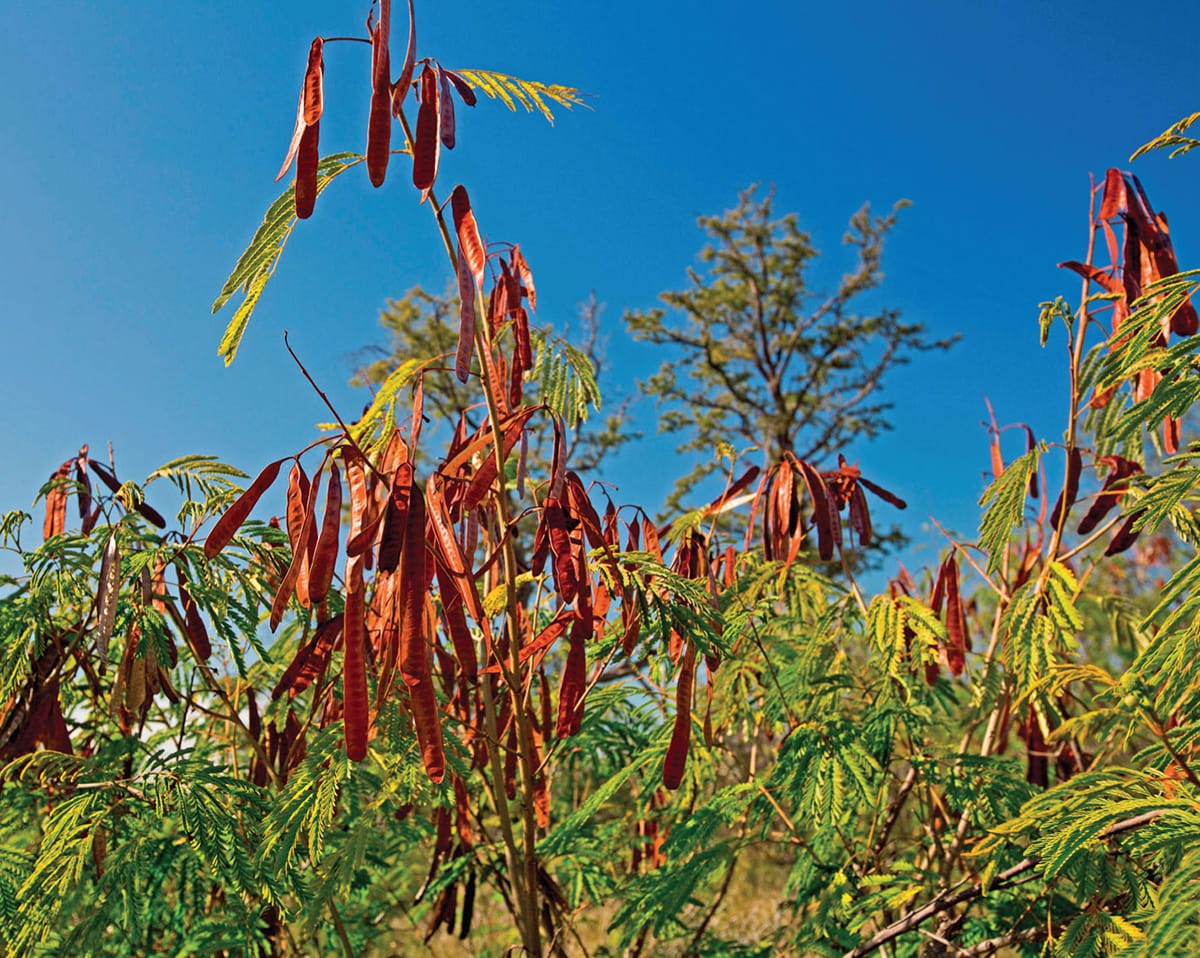
White leadtree (Leucaena leucocephala) is a small, fast-growing tree from Central America that is widely grown in tropical regions for firewood and livestock forage. Sometimes called a miracle tree because of its nitrogen-fixing root nodules, it produces high-protein fodder while also improving soil fertility.
A bounty of brassicas
One of several mustard family species that has been domesticated, the wild cabbage (Brassica oleracea) is a coastal plant of southern Europe and the Mediterranean region. Its early cultivation in ancient times provided animal fodder as well as human food and medicines. Sea kale (Crambe maritima) and sea rocket (Cakile spp.), other strandline members of the same family, are still consumed in their original wild form as minor vegetables. Collard greens (B. oleracea var. viridis) and kale (B. oleracea var. acephala) are open, leafy crops that are close in form to their wild ancestor, the variety name acephala indicating that these plants have not been selected to develop a distinct head. Instead, selection in cultivation favoured the plants with the largest leaves. The densely overlapping leaves of the cabbage (B. oleracea var. capitata) head were developed by selecting for shorter internodes and an enlarged terminal bud. Brussels sprouts (B. oleracea var. gemmifera), in contrast, were bred for their enlarged axillary buds, which grow in tight spirals around the stem.
The versatile brassicas even merit a place on display. Ornamental horticulture has selected varieties of kale with colourful white, green and red foliage and interesting variations in leaf shape.

Just some of the great variety seen in brassica leaf crops. Left to right: Brussels sprouts (Brassica oleracea var. gemmifera), red cabbage (Brassica oleracea var. capitata), kale (Brassica oleracea var. acephala) and green cabbage (Brassica oleracea var. capitata). Red cabbages have been selected for their higher levels of anthocyanins.
Leaves that satisfy the senses
In our long relationship with plants, humans have found many uses for leaves that tap into the diverse chemistry of the secondary metabolites they contain – organic compounds that are not used in the growth and development of the plant, but play important roles in ecology. Although formerly considered mere waste products, secondary metabolites are now known to be part of a complex system, mediating the relationship between the plant, its physical environment and its competitors or predators.
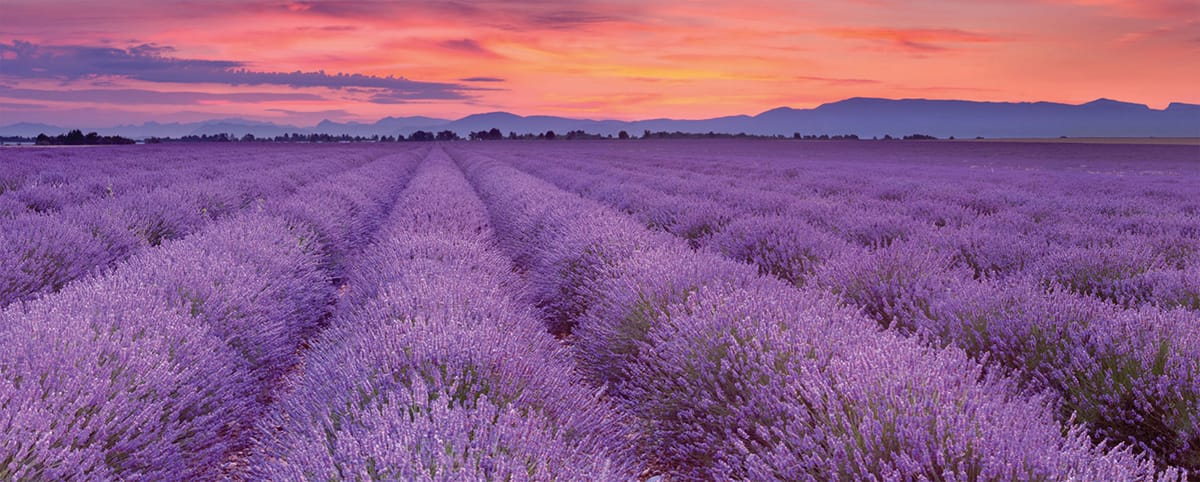
The Valensole Plateau in the Alpes-de-Haute-Provence of France, known as the ‘Lavender Country’, is renowned for the beauty of its landscapes, which are dominated by extensive fields of lavender (Lavandula angustifolia) and lavandin (Lavandula × intermedia). The Mediterranean climate and sunny slopes lead to abundant yields of essential oils.
Aromatic leaves
In members of the mint family (Lamiaceae), volatile oils are involved in temperature regulation, reducing water loss and mechanical damage, and defending the plant against herbivores and pathogens. The glandular hairs that secrete these chemicals have even been shown to act as detection sensors, responding to walking insects and triggering the activation of defence genes. The effects of the secondary metabolites they produce can be quite remarkable. Leaves of purple sage (Salvia leucophylla), for example, release monoterpenes into the air, or from dead leaves into the soil, which inhibit the germination of seeds of nearby competitors. Leaves of thyme (Thymus spp.), oregano (Origanum vulgare) and basil (Ocimum basilicum) have all been shown to have antimicrobial properties, disrupting the cell walls and metabolism of bacteria and fungi. Little wonder then that Lamiaceae species and other plants rich in secondary metabolites have been used for thousands of years as culinary herbs and in traditional medicine. In addition to flavouring food, mint plants (Mentha spp.) have a long tradition of use in many cultures for their anti-inflammatory, analgesic and diuretic properties. Similarly, lavender (Lavandula angustifolia) oil is widely used as a fragrance, is noted for its calming effect and, more recently, has been found to be effective against protozoal Giardia and Trichomonas pathogens. The presence of essential oils in the leaves of culinary herbs adds not only flavour to food, but also acts as a natural preservative agent.
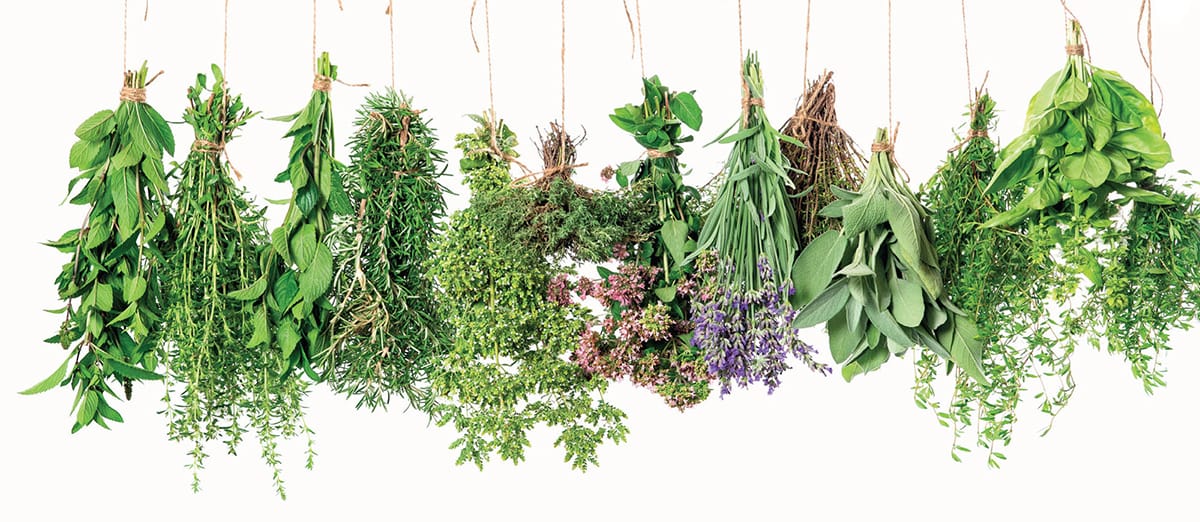
Bunches of culinary herbs, representing just part of the diversity found in the mint family (Lamiaceae), being preserved for later use by air drying.
Stimulating leaves
Alkaloids (nitrogen-containing heterocyclic compounds) are secondary metabolites produced in different plant organs as a defence against herbivory. Some alkaloid-containing leaves have a long history of human use thanks to their psychoactive properties. Caffeine is present in the mildly stimulating beverages prepared from the leaves of tea plants, where it occurs with theobromine, and in yerba mate (Ilex paraguariensis), in which a second alkaloid is xanthine. The consumption of cocaine, a much more potent tropane alkaloid extracted from the leaves of coca (Erythroxylum coca), dates back more than 8,000 years in Peru, and today generates billions of dollars in illegal trade.
Ornamental leaves
The shapes and colours of leaves are a principal element in ornamental horticulture and garden design. In addition to drawing directly on the diversity of foliage found in nature, gardeners have selected numerous forms with unusual shapes and variegation. Often these are discovered as sports, or chance mutations, and can be maintained only by vegetative propagation because the distinctive feature will not be inherited. Horticulturists exploit the ability of different plant organs to regenerate or to be grafted onto the stems of close relatives. In variegated hydrangeas (Hydrangea spp.), for example, root cuttings are taken and new plants generated from these, while variegated shell gingers (Alpinia zerumbet var. variegata) are grown from divided rhizomes. In the case of trees such as the fern leaf beech (Fagus sylvatica var. asplenifolia), cuttings are taken and grafted onto rootstocks from the parent species.

Tea (Camellia sinensis) pickers in the hills of Sri Lanka harvest the youngest leaves from new growth. Originally cultivated in China, tea is now grown in many countries around the world.
Floral extracts
Compared to roots, stems and leaves, or seeds and fruits, few, if any, flowers can be considered significant edible crops. Many are, in fact, edible, including nasturtium (Tropaeolum spp.) and pumpkin (Cucurbita pepo) flowers, day lilies (Hemerocallis spp.) and the young inflorescences of banana plants (Musa × paradisiaca). However, none of these species has been bred or developed to enhance their flowers for the purpose of consumption, mainly because these structures have relatively limited nutritional value.
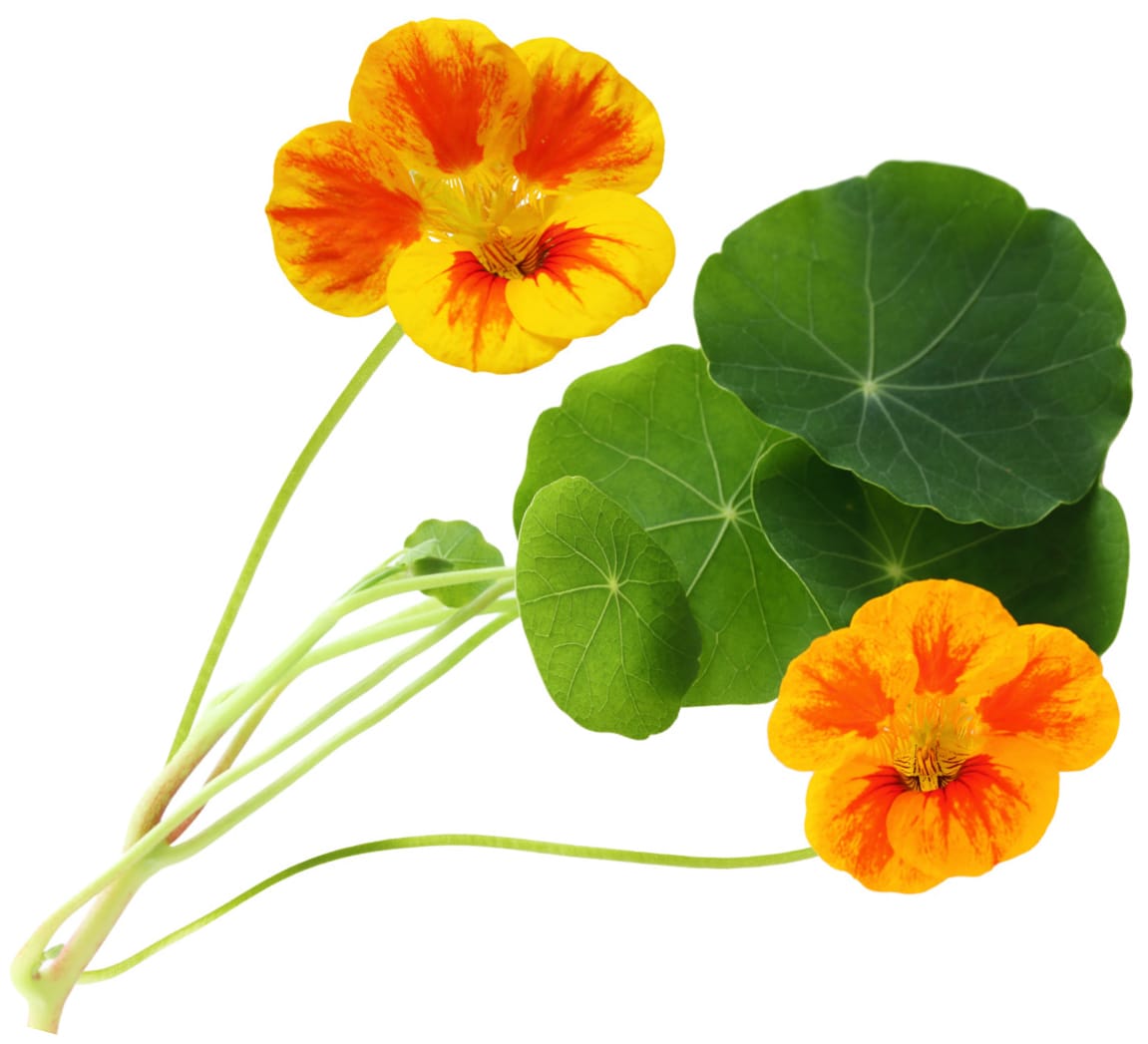
Nasturtiums (Tropaeolum spp.) are popular garden plants grown for their showy, colourful flowers and attractive foliage. The flowers are edible and, like the leaves, have a peppery rocket-like flavour.
Floral teas
The pleasing aromas of flowers, used by the plant to attract pollinators (see here), have led to many kinds being used to make herbal teas, consumed both as beverages and as traditional medicines. Chamomile (Matricaria chamomilla) tea, which promotes relaxation and sound sleep, is one of the most familiar. Lime (Tilia spp.) flower teas are a rich source of flavonoids, and are used to treat coughs, colds and high blood pressure. Chrysanthemum (Chrysanthemum morifolium and C. indicum) tea, used in China and elsewhere in Asia, is both a refreshing drink and a treatment for ailments such as sore throats and circulatory problems. Hibiscus tea from roselle (Hibiscus sabdariffa) is popular throughout Egypt, Latin America, the Caribbean, Africa and Asia. The bright red flowers contain anthocyanin pigments that are said to help reduce blood pressure.

Dried rose (Rosa spp.) flowers for sale in a street market in Kunming, China, are used for their fragrance to flavour hot drinks, either on their own or together with tea leaves.
Hops and brewing
One significant crop that is a flower (or, strictly, an inflorescence) is the hop (Humulus lupulus), used in brewing to impart a bitter flavour to beer. It has been the subject of extensive breeding programmes, which rather than influencing the morphology of the plant, a dioecious vine, have been targeted towards developing a distinctive taste. More than 80 commercial hop varieties have been bred, each giving a particular regional flavour to the resulting beer. Only the cone-like female inflorescences are used in brewing. Situated in the axils of leafy bracteoles, these each contain a single ovule and the outer surface of the ovary is covered with numerous multicellular, bright yellow glandular hairs known as lupulin glands. These produce the terpenoid essential oils and terpenophenolic resins that are used to balance the sweet flavour of malt and, thanks to their antibiotic properties, to prevent beer from spoiling during storage. Hops are also used in traditional medicine to promote sleep, and some of the many compounds produced by the lupulin glands are now being tested as potential anti-cancer drugs.
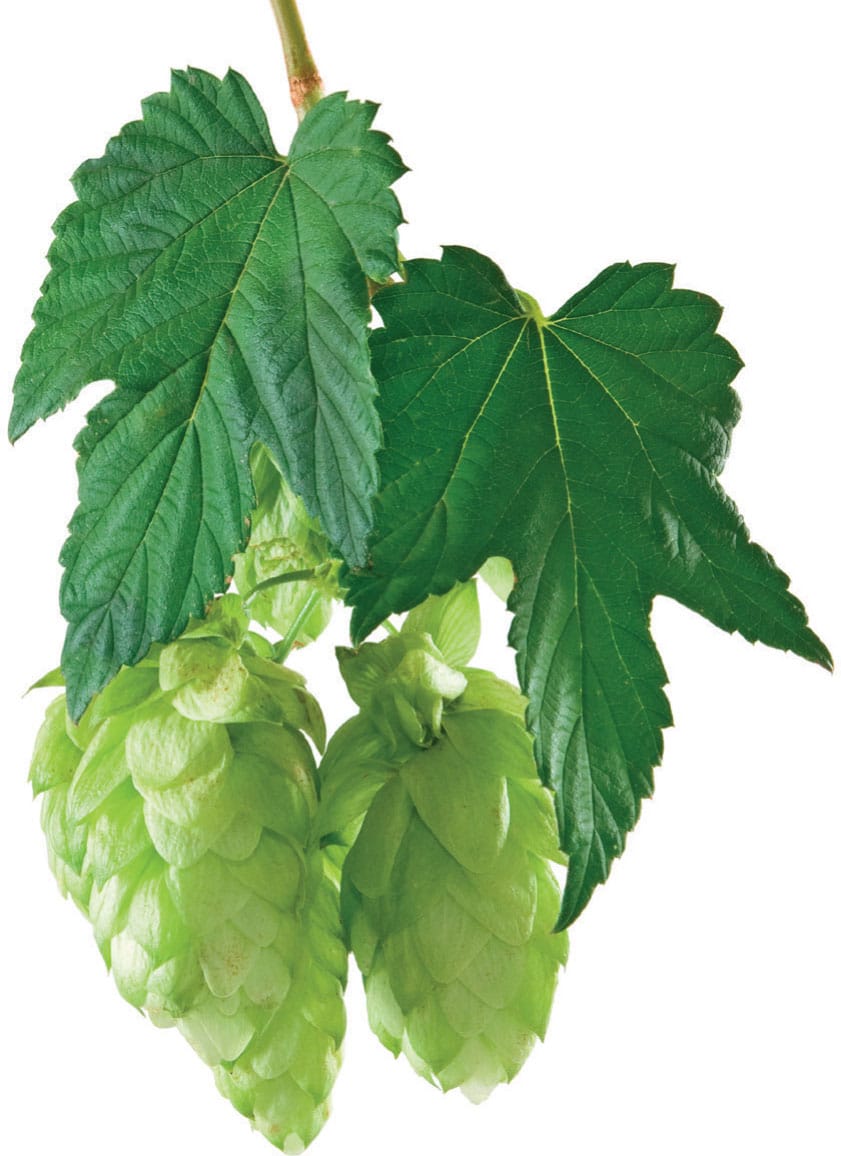
Cone-like female inflorescences of hops (Humulus lupulus), in which each pale green bracteole encloses the ovules, which provide the bittering agent used in brewing.
Precious perfumes
The most precious products obtained from flowers are the perfumes prepared by concentrating essential oils from the petals, which in the plant serve to attract pollinators. The oil from petals of Damask rose (Rosa × damascena), lily of the valley (Convallaria majalis) and ylang-ylang (Cananga odorata) are three classic examples, blended with animal musks to make premium perfumes. In ancient times, fragrances were obtained by expression, compressing flowers and other parts of plants to squeeze out essential oils. By medieval times, distillation was used to extract floral fragrances and perfumes became increasingly important as luxury products. As with floral teas, most of the essential oils used as perfumes also have traditional medicinal applications. Lavender (Lavandula spp.), for example, has been used since antiquity as an antiseptic agent, and today is a common ingredient in soaps and cleaning products. Fragrances themselves were long thought to protect against disease, and in medieval times plague doctors carried flowers and aromatic leaves in protective face masks.
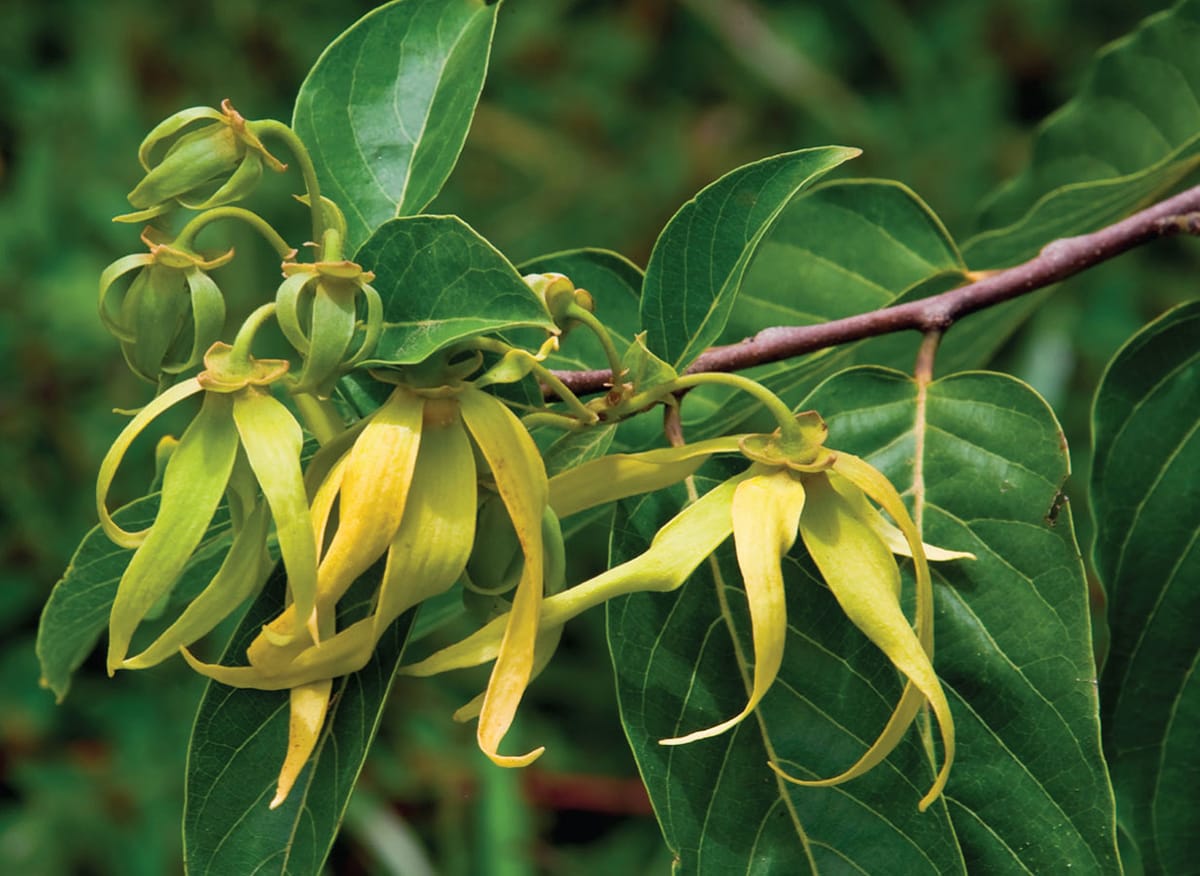
Above: The flowers of the cananga tree (Cananga odorata) from Indonesia are the source of the perfume ylang-ylang. Below: Antique copper perfume still from the museum of Maison Fragonard, Grasse, France, used to extract essential oils by passing steam through a layer of flowers and condensing the watery distillate. The essential oils float to the surface and are collected.

The beauty of the flower
The astonishing diversity of forms and colours by which flowers advertise themselves to pollinators has long been prized for aesthetic reasons in ornamental horticulture. Flowers have been selected and bred to increase their visual impact, with the result that the choicest examples are often quite different from their wild ancestors. During the golden age of exploration, wealthy European landowners sponsored plant-hunting expeditions around the world to discover and bring back new plants to be admired in their gardens.
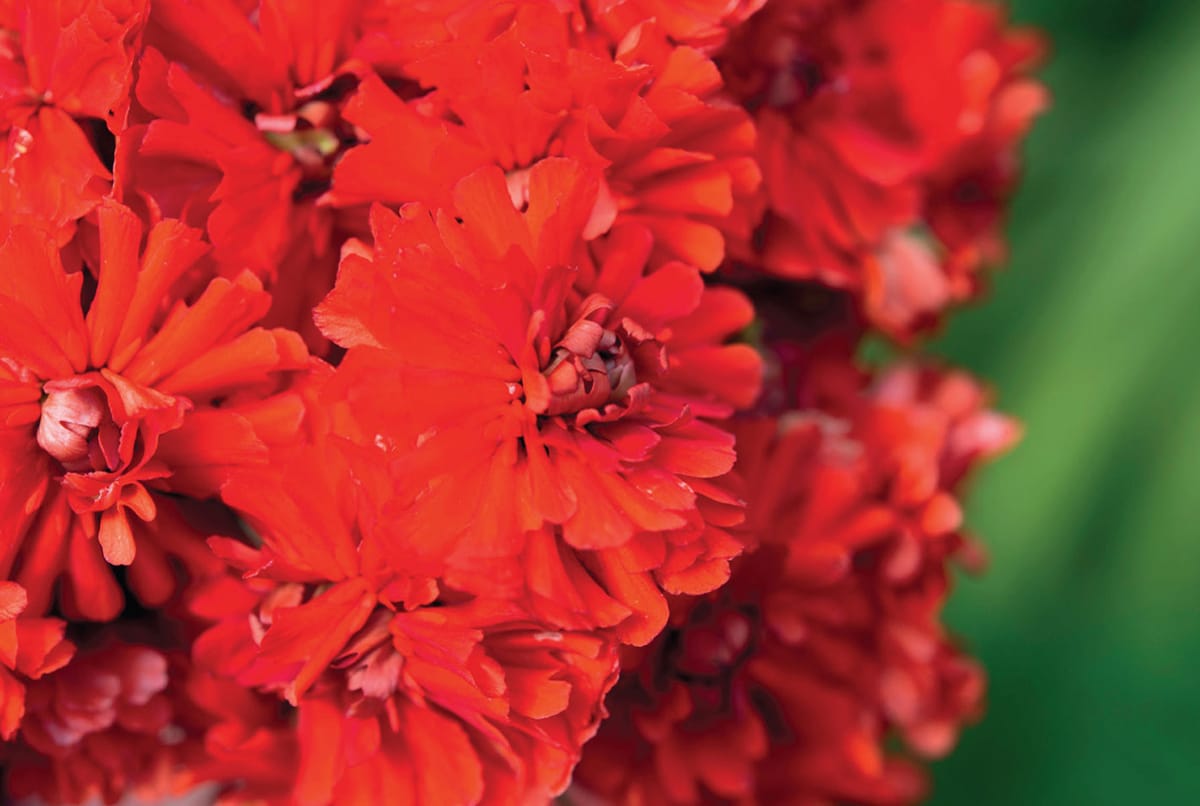
The double-flowered form of Maltese cross (Lychnis chalcedonica ‘flore pleno’) produces dense heads of scarlet flowers.
The more the merrier
Simply bringing the beauty of nature into cultivation at home has never been enough to satisfy some gardeners. When it comes to petals, the more the merrier is the rule for many, and there has been a long fascination with double-flowered forms. Roman naturalist Pliny the Elder wrote of the hundred-petalled rose (Rosa sp.), double peonies (Paeonia spp.) were prized in China and written about in the ninth century, and Gerarde’s Herball illustrated several double forms of flowers. Double-flowered varieties are often given the Latin name flore pleno and result from a homoeotic mutation, which causes the stamens to be replaced by additional whorls of petals. Commercial breeding has developed many double-flowered forms, especially of roses, camellias (Camellia spp.) and carnations (Dianthus caryophyllous).
Improving on nature?
Hybridization – one of the main ways of introducing new colour schemes into flowers – is achieved by manually transferring pollen from one parent to the stigma of the other. Amateur and professional breeders have created more than 3,000 named varieties of day lilies in this way, which have been selected for their colour, pattern and flower size, which is now twice as large as in the original wild plants. Once the desired outcome has been created, new plants can be produced sexually from seed or, to reduce the potential for variation, asexually by tissue culture. The latter technique involves growing plants in test tubes on an agar growth medium, and has also been used to great effect in making moth orchids (Phalaenopsis spp.), once the preserve of specialist growers, readily available in an enormous variety of colours.
Since the late 1980s, researchers in Australia have been using genetic engineering to transfer the genes that produce the bright blue pigment delphinidin in delphiniums (Delphinium spp.) to roses, carnations and chrysanthemums. These three targets are the most valuable in the cut flower industry but none has naturally occurring blue pigments. Whether success will result in significant sales remains to be seen, but much energy has been put into what some consider the holy grail of horticulture.
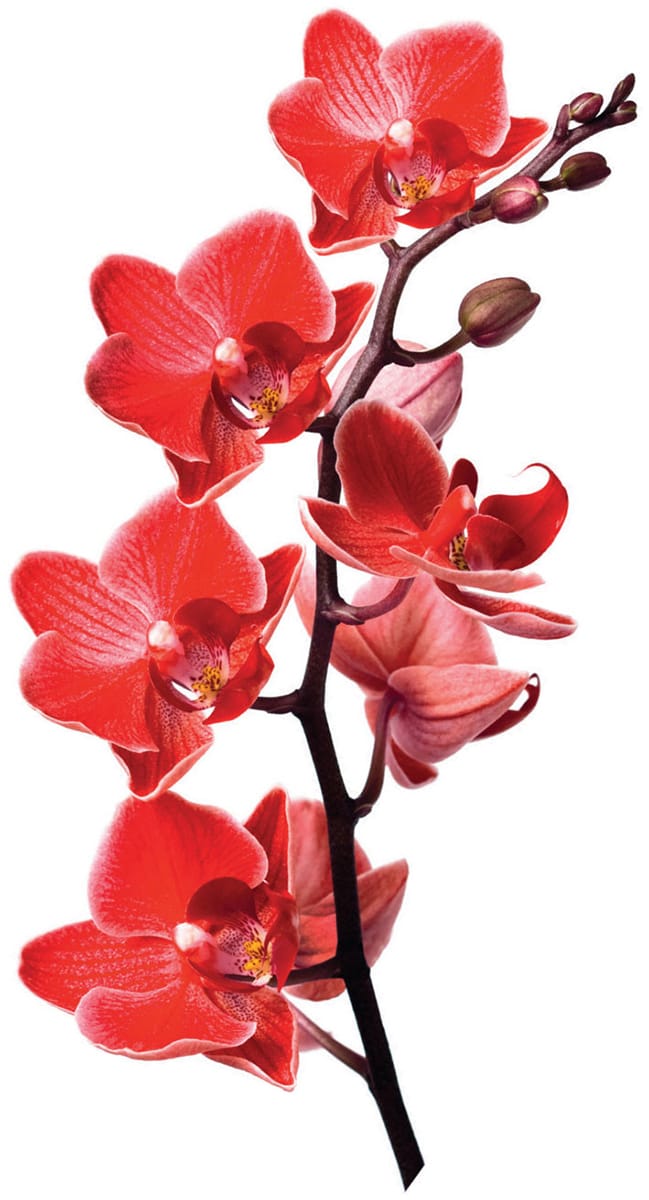
Thanks to breeding programmes and mass production using tissue culture, moth orchids (Phalaenopsis spp.) have gone from exotic rarities to readily available house plants.
Our daily bread
Cereals are staple foods and the foundations of civilizations around the world. In morphological terms, how have they been transformed from wild grasses? Most obvious is the increase in kernel size, improving the yield of the crop. But in the newest varieties, grain size is only part of the story, as each organ of the plant has been fine-tuned and enhanced. Ultimately, increased yield depends on overall performance and ability to grow rapidly with minimal input of fertilizers and pesticides, even in conditions of drought and salinity.

Bread has been one of the world’s most popular staple foods since the origins of agriculture. Yeast spores, naturally occurring on the surface of cereal grains, act as a leavening agent.
The growth of wheat
The Neolithic people of the Fertile Crescent exploited several kinds of wild annual grasses bearing nutritious seeds that could be ground into flour, usually after toasting them to remove the husks. By keeping and sowing the best seed, they began the process of domestication. One of the earliest kinds of wheat was first cultivated from wild einkorn (Triticum boeoticum) around 8000 bce in southeastern Turkey. Selection by early farmers gave rise to the cultivated einkorn (T. monococcum), a diploid with slightly larger grains and a valuable mutation. In the wild type, the delicate rachis shatters to disperse the spikelets during ripening, whereas in the mutant form the rachis is toughened and remains attached to the ear. This made harvesting and processing much more efficient.
The same mutation was selected for in a second of several other early wheats, emmer (Triticum dicoccon), a naturally occurring tetraploid hybrid of two diploid species, T. urartu and a goatgrass (Aegilops sp.). An important later development was the hybridization of emmer and Tausch’s goatgrass (A. tauschii) to produce the cold-tolerant hexaploid bread wheat (T. aestivum), whose seeds have a higher gluten content, making the flour suitable for leavened bread. Bread wheat and durum wheat (T. durum) have also been selected to produce naked or forms with thinner, more delicate glumes, removed as chaff during threshing.
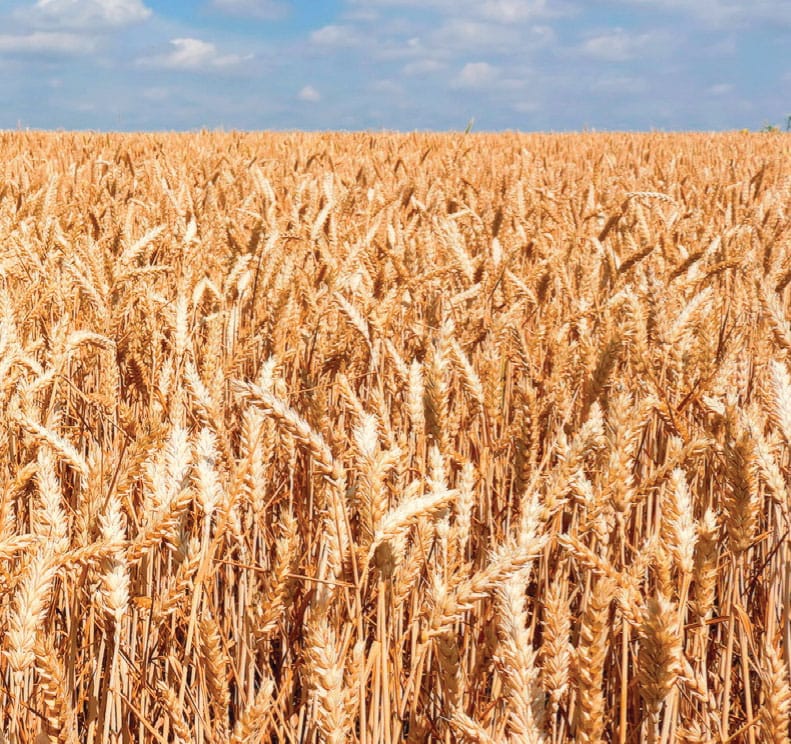
A golden field of ripening wheat (Triticum aestivum), the world’s third-most important crop in terms of calories consumed. This reflects the adaptability of wheat, which can be grown from sea-level to altitudes above 3,000 m (10,000 ft) and on a wide variety of soils, with both spring and winter varieties being available.
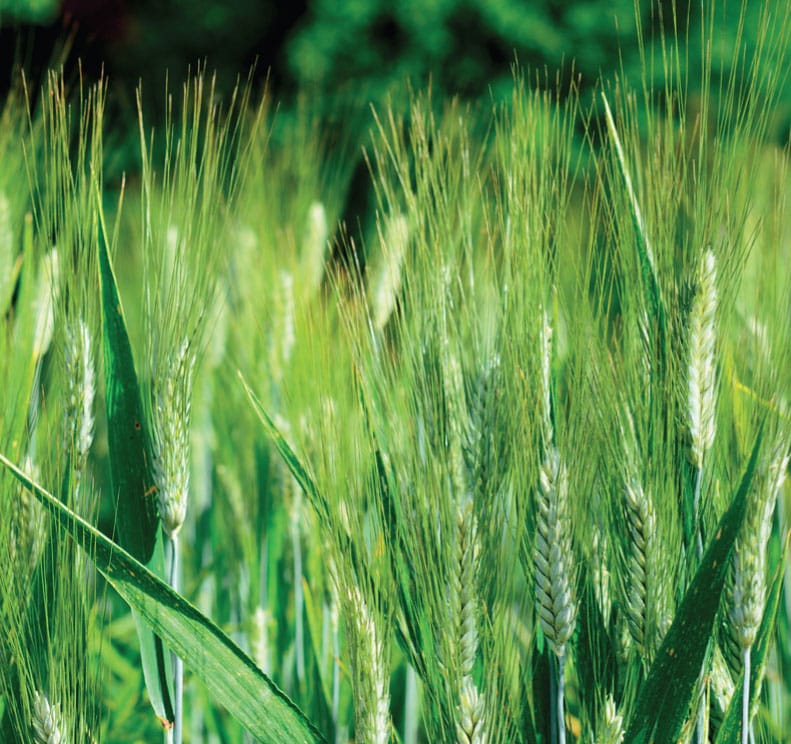
Cultivated emmer wheat (Triticum dicoccon) was originally selected for because of the ease with which its grain can be harvested. Unlike those of its wild relatives, the spikes do not ‘shatter’ into separate grains when ripe.

Wild einkorn wheat (Triticum boeoticum) from the Fertile Crescent was one of the first cultivated crops. It produces low yields of grain but can be grown on poor, dry soils.
Reaping the harvest
As wheat cultivation spread, other grasses travelled with the seeds as weeds, including some that turned out to be better suited to growing in the new conditions they found themselves in. Wild barley (Hordeum spontaneum), for example, which occurs from North Africa through the Middle East to Tibet, grew even better than bread wheat in cold climates and was the progenitor of cultivated barley. Similarly, oats, millet (various species in the tribe Eragrostidae) and sorghum were first dispersed as weeds before thriving in cultivation in the warmer climate of Africa.
Successful selections
Other early varieties of wheat, including spelt (Triticum spelta), durum wheat and their wild relatives, serve as a valuable gene pool for modern plant breeders. Important traits introduced during the Green Revolution (see box) include short stems that do not collapse, as early varieties would, when grown with high levels of chemical fertilizer. Reduced height (Rht) dwarfing genes from the Norin 10 wheat cultivar developed in Japan in the 1930s have reduced sensitivity to the plant hormone gibberellin, which regulates cell extension in the stem. In addition, winter and spring wheat varieties have been developed for cultivation in different regions, and drought and salinity tolerance in wheat are being increased through marker-assisted selection (MAS). Complete DNA sequencing of the wheat genome has identified more than 96,000 genes, originating from five distinct genomes of ancestral species. A longer-term grand challenge for plant scientists is to introduce nitrogen-fixation systems from legumes into wheat, the world’s most important crop, and other cereals.
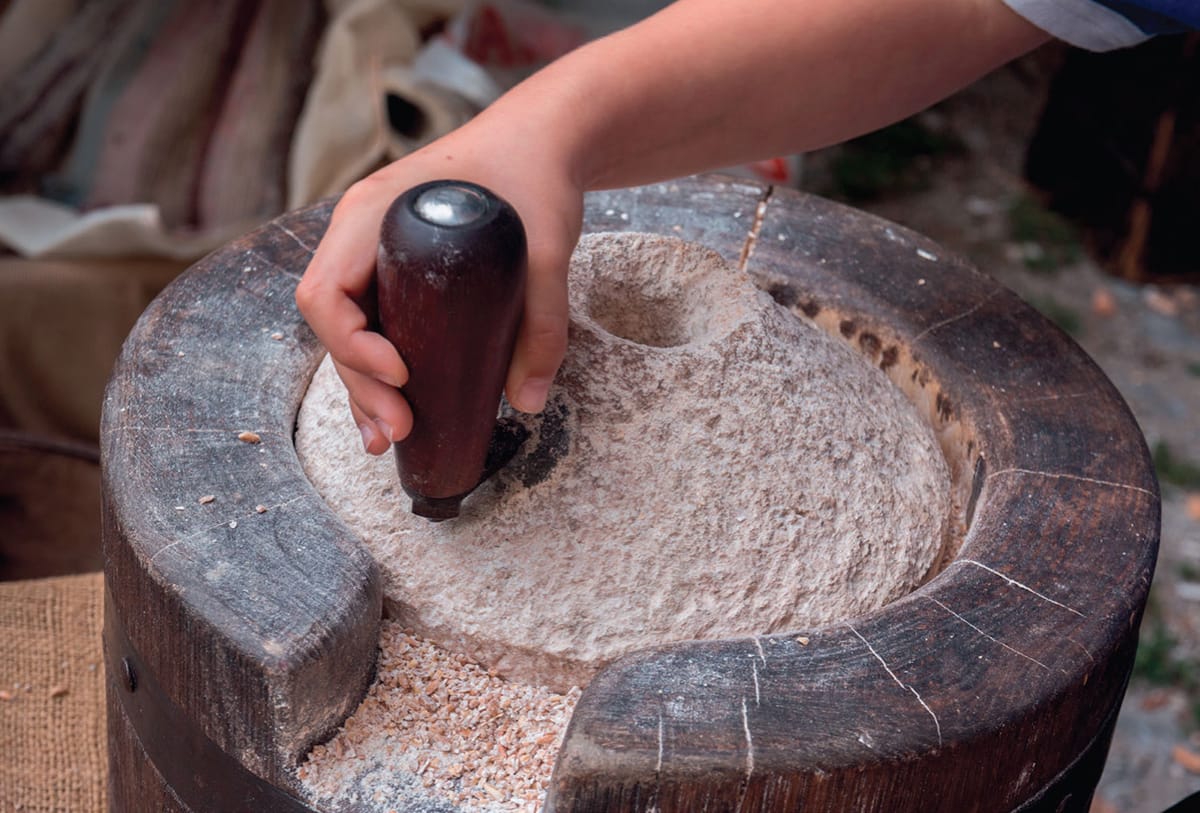
In ancient times, querns – small hand-turned grindstones – were used to mill cereal grains into flour. Water- and wind- powered mills, serving entire communities, were among the first applications of machinery.
Non-cereal seed crops
The seeds that contribute most calories are undoubtedly cereals, but other important seed crops with equally long histories provide different nutritional benefits. Some, such as rapeseed (Brassica napus), have been grown for oil since antiquity. Oil from the original form of this plant is unsuitable for consumption, but selective breeding to increase yields and reduce harmful chemicals led to the development of canola oil, now the third most important plant oil in commercial trade. Oils from rapeseed and the seeds of other plants are also used in the manufacture of biodiesel.

Although rapeseed (Brassica napus) is an ancient crop, its cultivation has increased enormously in recent years as its uses have diversified. It is now a familiar sight in the landscape.
Amaranths
The ancient Aztecs of Central America cultivated amaranths (Amaranthus spp.) for their starchy seeds. Like maize and sorghum, amaranths are C4 plants (see here), photosynthesizing efficiently at elevated temperatures and in a wide range of soils and climates. The grain they produce is higher in protein and the amino acid lysine, which is scarce in most other grains. In South America, the Inca people domesticated quinoa (Chenopodium quinoa), a close relative of the amaranths and with similar qualities. The seeds of both are naturally toxic until boiled to remove the bitter-tasting saponins. Neither has been subject to much improvement, except to reduce bitterness. Numerous landraces, locally selected and maintained in cultivation, represent a rich source of genetic variability.
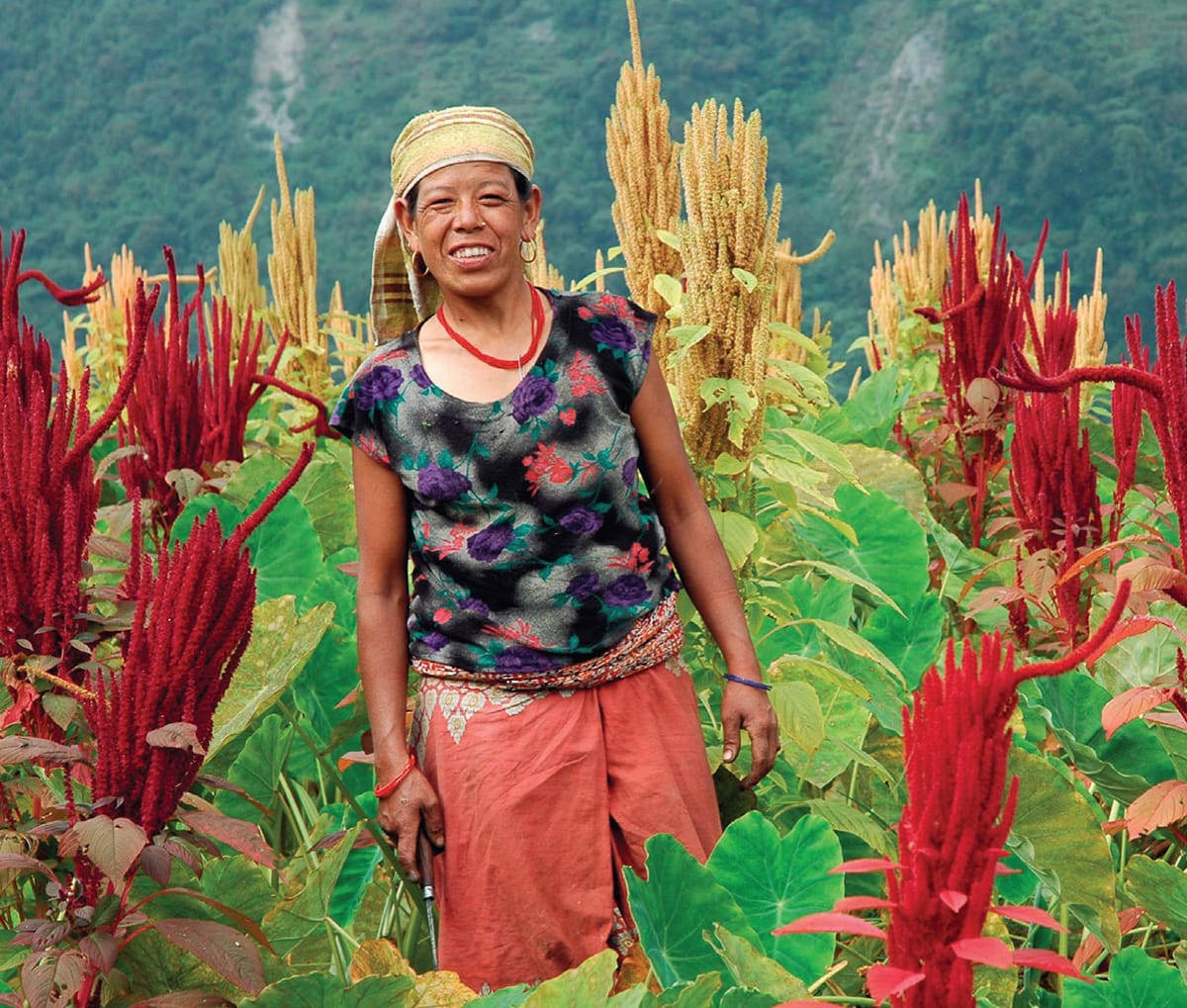
A local farmer alongside her colourful crop of amaranth (Amaranthus spp.), with its red and yellow flower spikes, growing together with the root crop taro (Colocasia esculenta) in the mountainous Ghandruk region of Nepal.
A finger on the pulse
The legume family (Fabaceae) is one of the most versatile and important to mankind, because the root nodules of the plants capture and fix atmospheric nitrogen, which increases the fertility of the soil. The characteristic pods contain seeds high in protein, and those harvested as dry grains are known as pulses. Like cereals, the fact that the seeds are dry enables them to be stored for extended periods after harvesting. Despite the importance of pulses as a source of protein for humans and animals, global consumption has been slowly declining. To promote their role in achieving food security, 2016 was declared the International Year of Pulses by the Food and Agriculture Organization, which recognizes 11 major types of pulses.
The distinctive biconvex shape of lentil seeds gave rise to the species’ scientific name, Lens culinaris. This ancient crop, grown by Neolithic farmers in the Fertile Crescent alongside einkorn and emmer, contains around 25 per cent protein - significantly more than cereals - and is drought tolerant and capable of growing on marginal land. Soya bean (Glycine max), another long-cultivated pulse, originating in east Asia and grown in China since at least 7000 BCE, contains up to 45 per cent protein. Despite their nutritional value, many pulses have indigestible integuments, used to protect the seed from insect predation. They therefore often require boiling and a long cooking period to degrade these compounds before they can be eaten, and much of the effort put into breeding pulses is aimed at reducing the levels of these substances.

Numerous varieties of lentils (Lens culinaris) have been developed. Left to right: petite estoria, split red lentils (the most familiar form in cooking) and green lentils.
Edible fruits
Whereas seeds are generally useful because, as plant propagules, they store energy for germination, fruits are adapted to facilitate and enhance seed dispersal. They come in a wide variety of forms. Some, like hazelnuts, with a toughened shell formed from the ovary wall, are used only for the nutritious seeds within. Others, such as green beans and snow peas, have fleshy pods that are harvested before they are fully ripe. However, most edible fruits offer a sweetened fleshy reward to animal dispersal agents.

The diversity of form nd flavour in fruits of the rose family (Rosaceae) is remarkable. The apple (Malus domestica) fruit is a pome, while both blackberry (Rubus fruticosus) and strawberry (Fragaria × ananassa) have aggregate fruits. The blackberry is an aggregate of many, whereas the strawberry in an aggregate accessory fruit in which the fleshy part develops from the receptacle of the flower. The cherry (Prunus avium) fruit is a drupe.
Fruits of the rose family
The rose family (Rosaceae) is one of the most economically important in the plant kingdom, with a long history of domestication. The fruits of apples and pears, known as pomes, are formed from the swollen, fleshy calyx tube and receptacle within which the carpels are embedded. The apple (Malus domestica) originated in central Asia and was probably the first tree to be domesticated; it is now the most widely cultivated fruit tree of temperate regions. To ensure the desired characteristics of a cultivar are maintained, propagation involves grafting onto rootstocks, the choice of rootstock determining the size of the tree. Commercially, compact trees on dwarfing rootstocks are preferred. This technique has a long history - around 300 BCE, Alexander the Great of Macedonia sent dwarf apples to Athens, and grafting was also widely practised in ancient Rome.
Cross-breeding between apple varieties has resulted in an enormous number of cultivars suited for three main uses. Dessert apples have been selected for colour, size, texture and flavour. Many early varieties had russeting, or areas of rough brownish skin; while this character is preserved in some modern cultivars, it has been carefully bred out of most. Cooking apples are generally larger, with a tart flavour, while cider apples have been bred for the highest levels of sugar, required for fermentation, combined with tannins for taste.
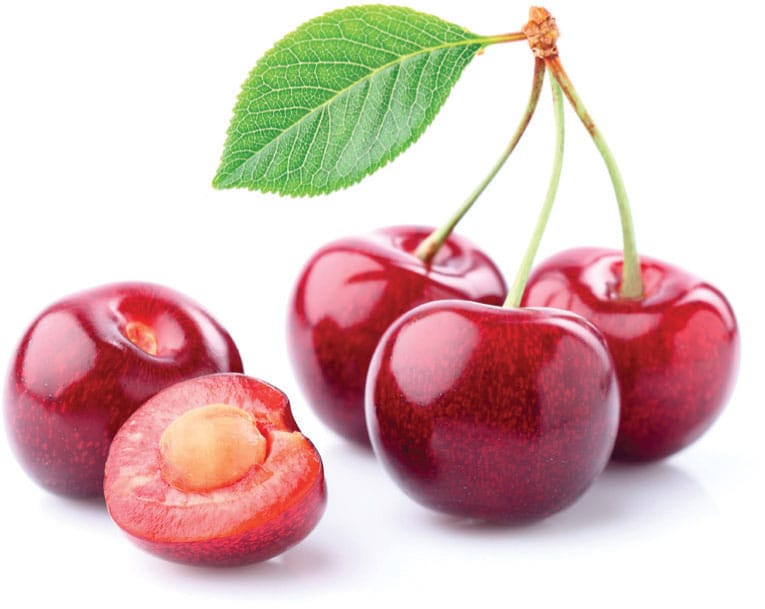
Pear trees (Pyrus spp.) have similar origins and diversity to apples, with three main species in commercial cultivation and fruits that can be ‘pear-shaped’ or resemble apples. Other pomebearing species with long histories of cultivation include quince (Cydonia oblonga) and medlar (Mespilus germánica) from southwest Asia, and loquat (Eriobotrya japónica) from China. Medlar fruits are unusual in that they are not eaten until they have been bletted, a process of softening that goes beyond ripening and involves the breakdown of cell walls after the fruits have been left on the trees and exposed to frost.
Going bananas
Bananas (Musa spp.), tropical and subtropical species with a starchy fruit, are now the fourthlargest cultivated crop in the least developed countries. They were first domesticated in Southeast Asia and Papua New Guinea, perhaps as early as 8000 BCE, from two ancestral species, M. acuminata and M. balbisiana. Both of these have numerous large seeds, so selection by early farmers focused on propagating parthenogenetic plants, which develop sterile fruits without fertilization taking place. A complex history of hybridization and dispersal of banana cultivars saw different lines migrating into India and Africa, and onwards around the world. Current annual production totals more than 100 million tonnes, but is based on a narrow genetic base, with widely grown cultivars such as ‘Cavendish’ being highly susceptible to pests and diseases.

Musa balbisiana, one of the wild ancestors of the modern cultivated banana. Although the flesh contains so many large seeds that it is now considered inedible, it is assumed that the fruits were cooked and eaten as a starchy food before the development of modern varieties.
Oils and spices
Some important plant oils, used as lubricants and for foods, are produced by crushing ripe fruits. Olive (Olea europaea) was first domesticated in the Fertile Crescent and has been a traditional tree crop in the Mediterranean since at least 8000 BCE, while oil from the African oil palm (Elaeis guineensis) has been used since at least 5000 BCE to produce a highly saturated fat. Spices – dried aromatic plant products, often highly valued for their culinary uses and medicinal properties – also have a long history, being some of the earliest commodities traded around the world.

An African oil palm (Elaeis guineensis) plantation on recently cleared forest land in Thailand. Since its introduction to Java in 1848, the palm has become widely grown in Asia, often at the expense of rainforest.
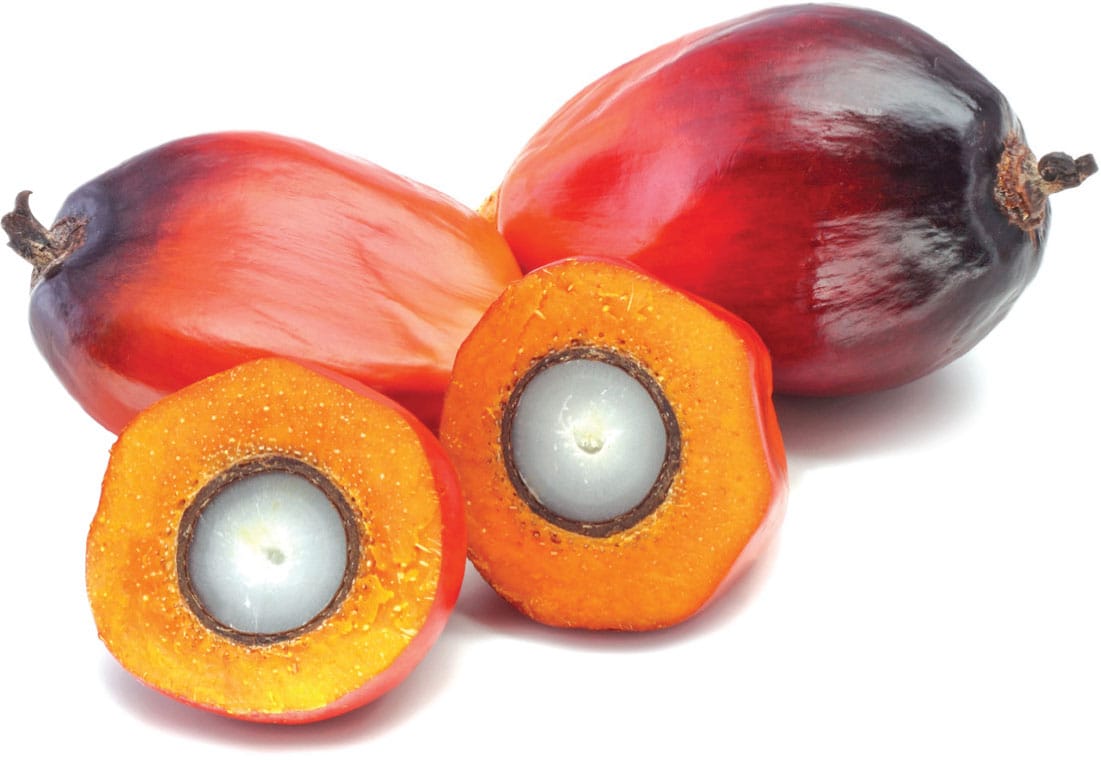
Palm oil comes from the reddish mesocarp of the African oil palm fruit, while the white inner kernel produces palm kernel oil.
Black peppers
The world’s most traded spice today is black pepper, the fruit of the black pepper plant (Piper nigrum). This perennial woody vine, native to south and Southeast Asia, has been used in Indian cuisine since at least 2000 BCE. The fruit is a drupe, with an outer fleshy part surrounding a hard endocarp and a single seed. Domestication led to increased yields and enhanced quality, without significantly changing the morphology of the plant. Black pepper was carried from India across the Indian Ocean to Egypt and Rome, along a route that persisted for thousands of years. The fall of the Roman Empire reduced this trade, but it expanded again during the Crusades, with Venice controlling and monopolizing operations in Europe. The seagoing nations of Europe explored new routes to break the monopoly. When Vasco da Gama reached India via the Cape of Good Hope in 1498, Portugal gained control of imports from the East Indies. The Dutch and British soon followed, establishing their own East India companies to import many commodities, including spices.
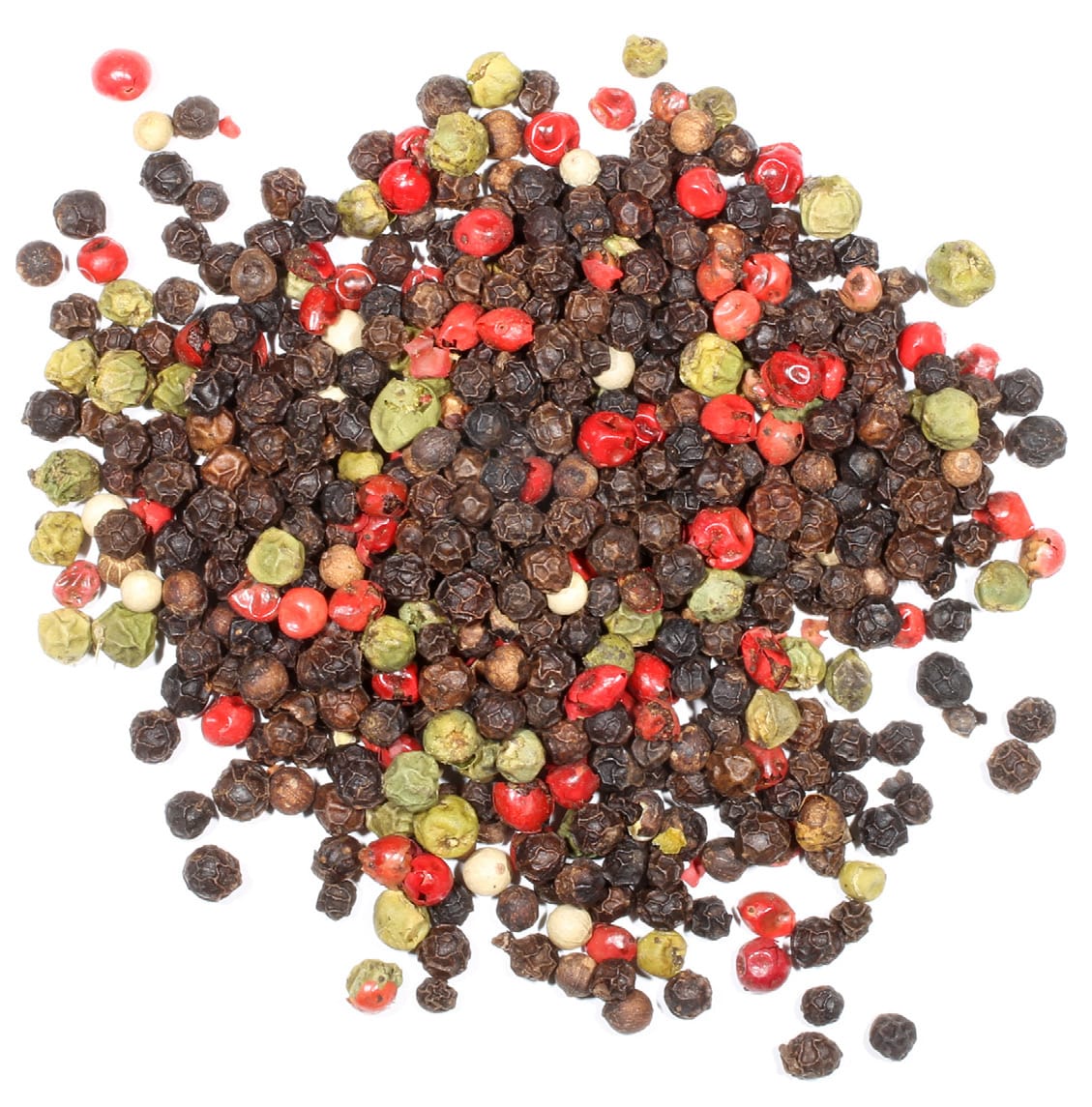
Mixed pink (Schinus sp.) and black (Piper nigrum) peppercorns, the latter having been harvested at different stages of ripeness.
A plethora of peppers
Fruits of long pepper (Piper longum) have a stronger taste than the closely related black pepper due to a higher content of the alkaloid piperine, and are used in Ayurvedic medicine. The long, dry catkins of minute fruits were also used as a medicine in ancient Greece. Other native species of Piper are consumed in west Africa, Mexico and Southeast Asia. The new world has its own native, pink peppercorns, from the Peruvian and Brazilian pepper trees (Schinus molle and S. terebinthifolius, respectively). These are often included, for their bright colour, in mixtures of whole peppercorns. The Chinese Sichuan peppercorn (Zanthoxylum bungeanum) is a member of the citrus family (Rutaceae), and is harvested for its intensely spicy, lemony peppercorns, which produce a tingling numbness in the mouth.
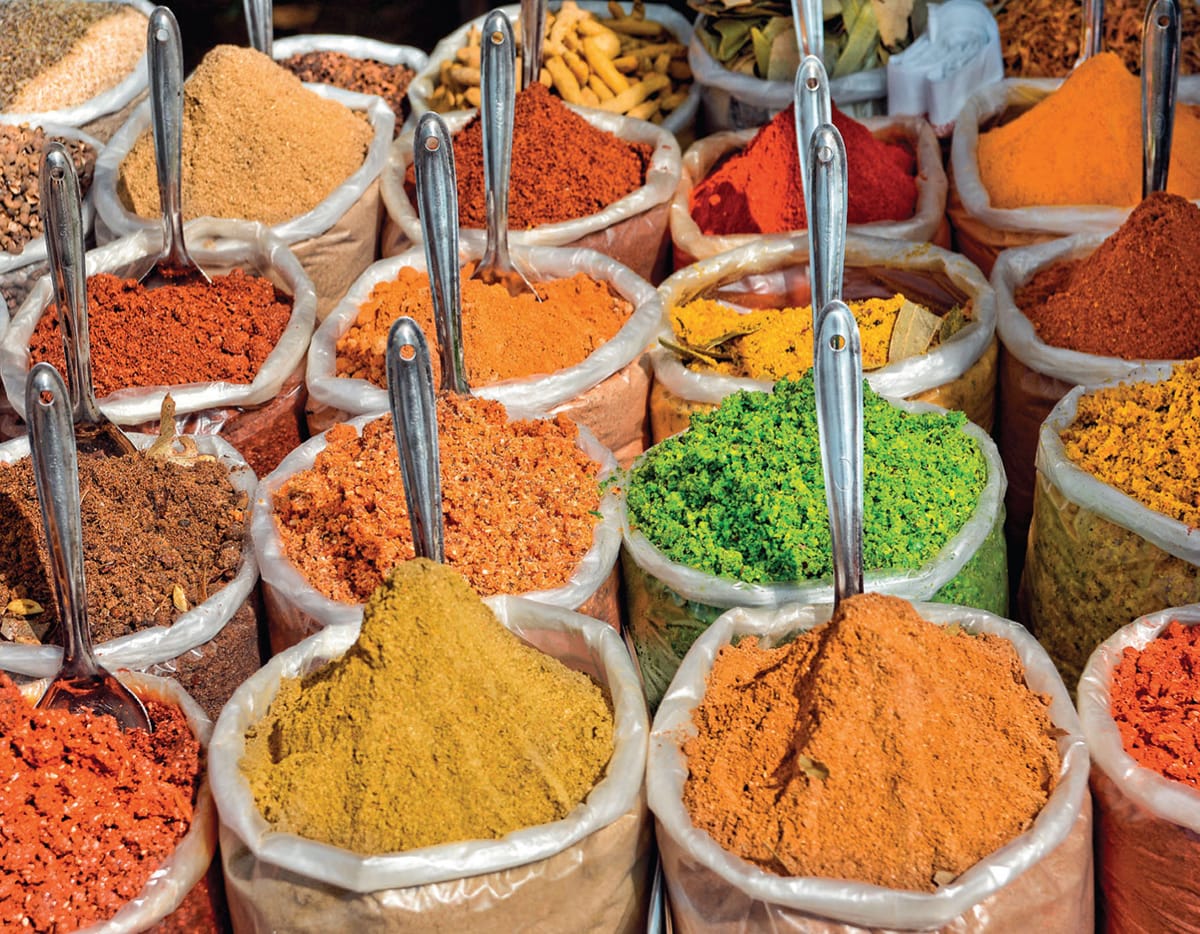
Spices in a marketplace in Anjuna in the North Goa district of India, formerly a Portuguese possession and a vital link in the spice trade to Europe.
Advances in plant breeding
As we saw earlier, plant breeding began with the straightforward selection for reproduction of plants considered to have desirable attributes. This process begins with the subjective choice of, for example, the plant specimens with the heaviest crop of fruits, and is based upon identifying and keeping these out of a wider pool of genetic variation. Over successive generations, this selective cultivation changes the genetic composition of the plants. Another key technique involves overcoming natural barriers to cross-breeding, to create hybrids, usually between closely related species, but sometimes between genera.

Pods, like those of the pea (Pisum sativum), are the typical fruits of the legume family (Fabaceae). The seeds within, each developed from a single ovary, are highly nutritious and can be dried for long-term storage.
Mendel’s peas
It was the Augustinian friar Gregor Mendel who, in 1856, began the experimental hybridization of different varieties of pea plants (Pisum sativum) and discovered the rules of what came to be known as genetic, or Mendelian, inheritance. He crossed peas that exhibited seven independent variable traits and found that in the resulting progeny one trait was always dominant. Tall pea plants crossed with short pea plants always resulted in tall plants, a condition Mendel described as dominant. When the resulting plants were crossed with each other, one in four of the next generation would be a short plant. Mendel called the factor that caused short plants to reappear recessive. Recessive factors, or genes as we now know them, do not exert their influence when the dominant gene is also present, but only when both parents pass on the recessive gene. The importance of Mendel’s discoveries was only fully appreciated in the early twentieth century, when his work provided a new understanding of the processes of natural selection and ushered in the science of genetics.
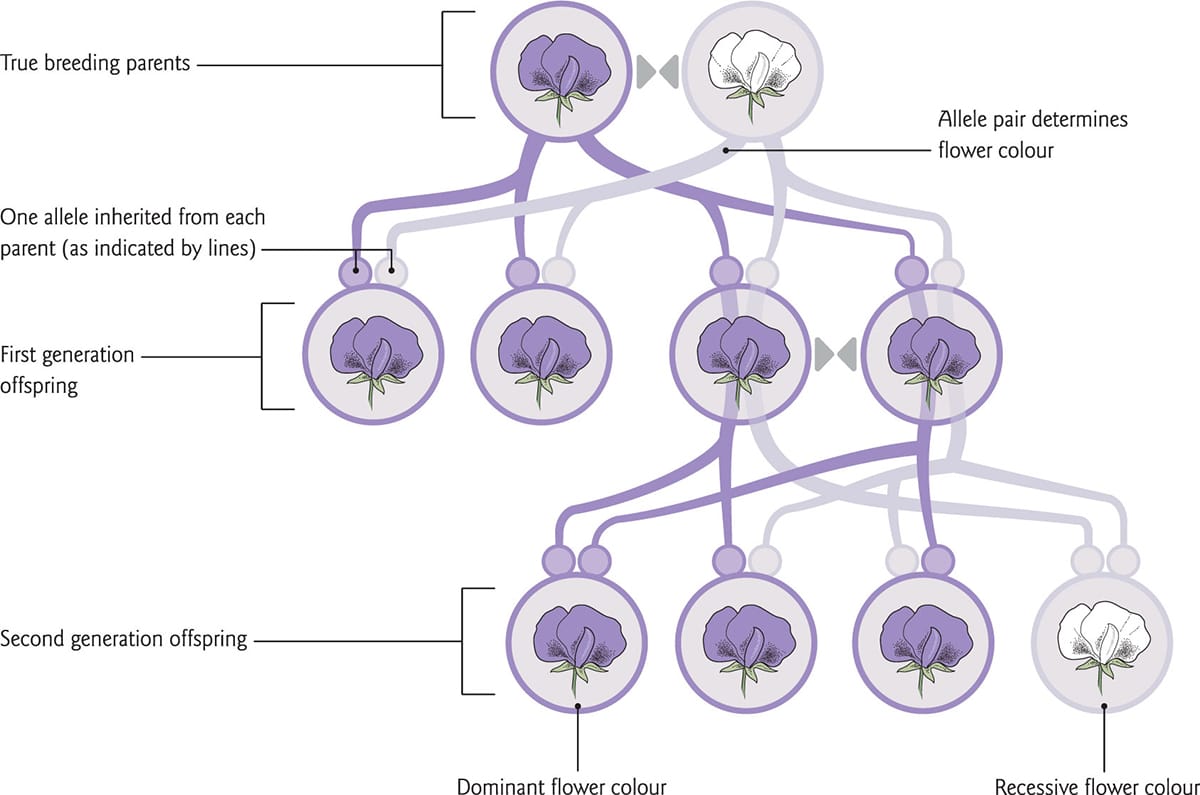
Flower colour in peas follows scientist Gregor Mendel’s rules of heredity. Purple and white flowers each breed true when crossed with their own kind, but when crossed together, purple colour dominates in the first generation of offspring, with white reappearing in the second.
Applied genetics
Equipped with a growing understanding of genetics, plant breeders began to develop much more targeted approaches to bringing traits of interest into cultivated plants. These include drawing upon the genetic diversity present in locally adapted landraces, in cultivars or in the wild relatives of crops. There are, however, many challenges to this approach, not least that traits frequently involve complex interactions between genes expressed in different plant organs at distinct stages in the life cycle.
Crosses between selected parents are usually performed manually, by transferring pollen from the male parent to the stigma of an emasculated female flower (the stamens are removed to prevent self-pollination). After this artificial pollination is complete, the flower is covered with a bag to prevent contamination by other unwanted pollen grains. Hybridization often results in infertile progeny containing an uneven number of chromosomes. In many cases, fertility can be restored by doubling the chromosome number, which is achieved with the use of colchicine to inhibit cell division. Further advances have since followed, making it increasingly possible to understand and interact with the entire genome of the plant.

To select for specific characteristics, pollen can be transferred by hand, on a cotton bud, from the anthers of the male parent and transferred directly onto the stigma of the chosen female plant.
The era of genomics
Our ability to manipulate plants in the laboratory has advanced rapidly in recent years, thanks especially to the ever-falling cost of sequencing entire genomes. The first plant genome to be sequenced, in 2000, was that of thale cress (Arabidopsis thaliana), chosen a decade earlier as a self-pollinating diploid with a short life cycle and comparatively small genome (135 megabase pairs). We can now assign functions to the 27,000 genes and the 35,000 proteins they encode in the species, and the complete genome sequences are available for numerous breeding lines.

With its well-understood genome and short life cycle, thale cress (Arabidopsis thaliana) is the model used for understanding how specific genes function in plants.

During spore production, the bacterium Bacillus thuringiensis (Bt) naturally produces insecticidal proteins.
Genetic engineering
Genetic engineering involves transferring the genes responsible for a specific trait directly into plants that lack those genes. One of the first applications involved transfer of the genes responsible for producing insecticidal proteins in the soil bacterium Bacillus thuringiensis (referred to as Bt). In 1995, Bt potato, containing transgenes producing the CRY 3A Bt toxin, became the first pesticide-producing crop to be approved for use in the United States, followed by Bt cotton and Bt maize. The area of land cultivated worldwide with genetically modified (GM), or transgenic, crops has increased dramatically, reaching more than 185 million hectares (700,000 square miles) in 2016. The most commonly planted biotech crops are maize, soya bean, canola and cotton, with 54 per cent grown in 19 developing countries and the balance in seven developed, or industrial, countries. More recent transgenic crops include proprietary Roundup Ready varieties, resistant to the broad-spectrum herbicide glyphosate.
Initial applications of GM technology were primarily directed towards more profitable production, while second-generation GM foods aim to offer benefits to consumers. ‘Golden Rice’, for example, is a variety of Oryza sativa that is being genetically modified with two transgenes to synthesize beta-carotene as a dietary precursor to vitamin A. Despite these benefits, genetic engineering continues to be contentious (see box).
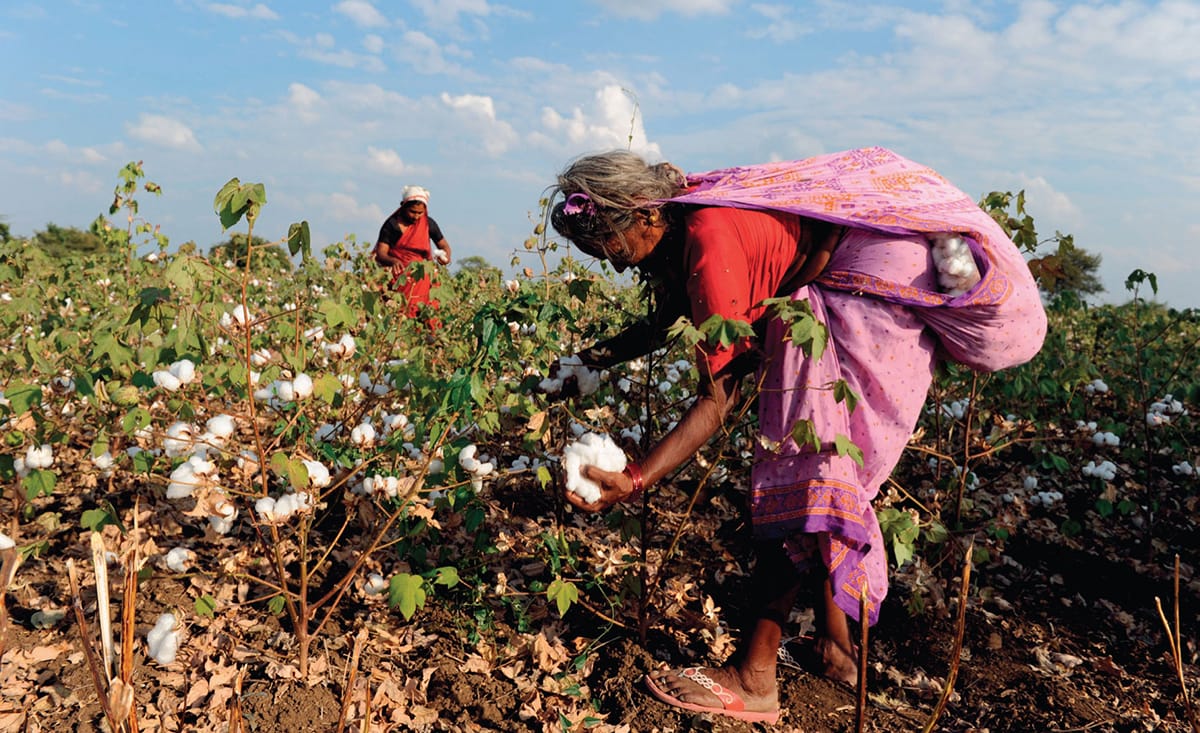
Harvesting a genetically modified crop of insect-resist-ant Bt upland cotton (Gossypium hirsutum) in Vidarbha, Maharashtra, India.
New and emerging technologies
Plant breeding is an important and fast-moving area of research, in which new ways of understanding and manipulating genes and their regulation are emerging all the time. Marker assisted-selection, for example, accelerates plant breeding by using DNA-based markers for the genes of interest, or marker sequences situated close to them on the chromosome. It can be applied to complex traits such as yield, drought tolerance and disease resistance involving multiple genes, and uses high-throughput DNA screening to determine rapidly whether the desired traits are present in the progeny produced by conventional crossing methods rather than through the transgenic approach.
Genome editing makes it possible to remove or replace DNA sequences using engineered nucleases, which cause doublestrand breaks at a specific point in the DNA and then repair the break with the insertion of new DNA. This enables trait stacking, in which several different genes can be brought together on the chromosome so that they will co-segregate during cell division, remain together during breeding and be inherited in successive generations. The gene-editing technology CRISPR, for example, has been adapted from a bacterial immune system that protects against viral attack.

Gene-editing techniques use a DNA-cutting enzyme to remove a precisely targeted region of DNA from a specific gene and replace it with a short strand carrying a different DNA sequence, thereby altering or repairing the function of the gene.
Conservation of plant diversity
International agreements such as the United Nations Convention on Biological Diversity recognize that, against the background of a growing global population and accelerating environmental change, we need to preserve as much biodiversity as possible for the future. The highest priority of the global community has been to protect the plants we rely on most - those that feed us. However, it is important to conserve diversity at the ecosystem, species and genetic level, regardless of whether we find individual plants useful for specific purposes or not.

In 2008, as insurance for the future, the Crop Trust created the Global Seed Vault in a mountain on a remote island in Norway’s Svalbard archipelago.

Inside the Global Seed Vault, dried seeds of crops from around the world are held at low temperatures, where they can remain viable for millennia.
Conserving crops
Since the 1960s, preserving the diversity of crops and developing new varieties has been the remit of a global network of 15 Consultative Group on International Agricultural Research (CGIAR) centres, dedicated to specific crops, ecosystems or regions. The public domain collections in their care are held in trust to guard against the dangers of agricultural dependence on limited genetic diversity. When we have relied on too few varieties, the results have sometimes been catastrophic. At least a million people died between 1845 and 1852 in Ireland’s Great Famine, when potato blight (caused by the fungus Phytophthora infestans) swept through Europe. Overdependence on a few cultivars, especially ‘Irish Lumper’, which was not resistant to potato blight, was a major factor. In the 1970s, an epidemic of southern corn leaf blight fungus (Bipolaris mayáis) destroyed a sixth of the maize harvest in the United States as a result of overdependence on highly susceptible Texas cytoplasm (cms-T) maize. It is now clear that we must preserve genetic diversity in crops as a source of future resilience and adaptability.
The International Rice Research Institute in Manila contributed to the Green Revolution (see box) through the development of semi-dwarf varieties, and is now pursuing the development of ‘Golden Rice’ (see here). The Centro Internacional de la Papa, in Lima, specializes in potatoes, sweet potatoes and other Andean roots and tubers. In 2004, the Crop Trust was established as an independent organization under international law to ensure the conservation and availability of crop diversity for food security worldwide. Its Svalbard Global Seed Vault on Spitsbergen holds duplicate collections from thousands of seed banks around the world as insurance for the future (see opposite).

The Famine statues by Rowan Gillespie stand in Ireland’s Dublin Docklands in memory of almost a million people who died in the Great Famine of 1845̵1849.
Wider plant diversity
A compelling case for preserving all plant diversity has yet to secure such support. Although we know that plants created, and maintain, the conditions necessary for animal life in the biosphere, it is sometimes argued that there is a level of redundancy, making it unnecessary to conserve all species. This rationalization is usually based on assigning plant species to functional groups, as though they were interchangeable pieces in a machine. However, a stronger moral case is that it would be indefensible to suggest that a species needs to prove its utility to us for it to be worth saving from extinction. It is often said we should preserve biodiversity out of enlightened self-interest. In truth, little enlightenment is needed to understand that ecosystem services - our life-support systems - depend on plant diversity. Fortunately, the global community of 3,000-plus botanic gardens and other organizations are rallying around the internationally agreed Global Strategy for Plant Conservation. The world’s botanic gardens already conserve and manage a greater proportion of the known plant species than any other sector.

Harvesting experimental beans (Phaseolus spp.) near the Colombian town of Darién for the International Center for Tropical Agriculture (CIAT).

Samples of tropical forages conserved in vitro at the CIAT gene bank in Colombia. Seeds of these plants have been sent to the Global Seed Vault in Svalbard for conservation.
Preserving plant diversity
Plants have many strategies for survival, including multiplying through sexual and asexual means and dispersing themselves widely. Efforts to preserve plant diversity tap into, and exploit, the fundamental biology of plants. Seed banks play a prominent role in this, given that many seeds can remain dormant for centuries. But not all seeds share this facility, so other forms of living collection are also required. An important consideration in each of these methods of ex situ conservation is to make sure that as much genetic diversity as possible is captured and preserved.
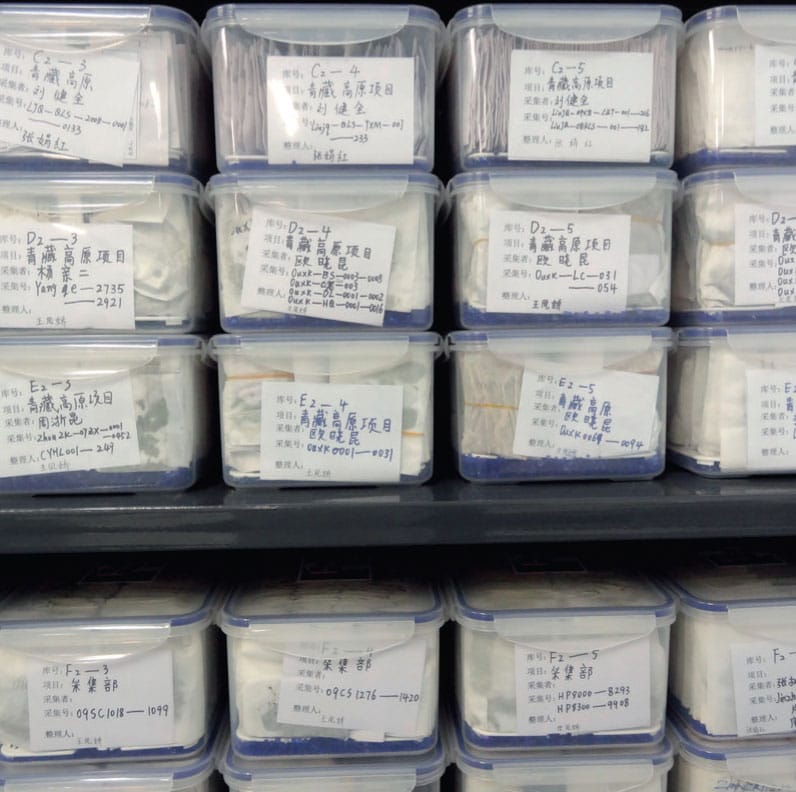
Samples of DNA from wild plant species are stored in carefully labelled and databased packets, kept dry with silica gel, at China’s Germplasm Bank of Wild Species in Kunming.
Seed banks
Seed banks are a very cost-effective way of conserving plant diversity for the 75 per cent of plants with orthodox seeds - those that can tolerate desiccation and freezing. Such seeds are generally small, have hard seed coats and have a dormant state that is broken only when the right environmental cues trigger germination. The standard protocol is to dry seeds to a moisture content of about 7 per cent before storing them at -20 °C (-4 °F). The world’s most diverse seed bank, the Millennium Seed Bank at the Royal Botanic Gardens, Kew, in London, developed viability tests and germination protocols suitable for wild plant species, many of which have never previously been brought into cultivation.
A key role of any seed bank is to supply plant material. The Svalbard Global Seed Vault has already done this, providing duplicate collections of seeds which were destroyed by the conflict in Syria to the International Center for Agricultural Research in Dry Areas. Recalcitrant seeds, which are often large, and have a thin skin and short dormant phase, cannot be banked in the conventional way, and must be conserved by cryopreservation or tissue culture (see box), or as living plants. Unfortunately, recalcitrant seeds occur in many important groups of plants, including oaks and their relatives in the oak family (Fagaceae), and in many groups of tropical trees.

A visually stunning display of seeds welcomes visitors to China’s national seed bank, the Germplasm Bank of Wild Species at the Kunming Institute of Botany in Yunnan province. With seeds provided by Kew’s Millennium Seed Bank, these fibre-optic rods originally appeared on the UK Pavilion at Expo 2010 Shanghai.
Living collections
Botanic gardens hold internationally important living collections of plant diversity. The PlantSearch database, maintained by Botanic Gardens Conservation International, has records of 1.3 million accessions held in around 1,100 institutions, and estimates that at least one-third of all plant species are kept in botanic gardens and arboreta. While that represents a significant resource, it is not yet sufficient to safeguard the future of plant diversity. Well-coordinated strategic actions are required to make the world’s living collections of plants fully representative of species and genetic diversity, combined with major programmes of collecting to acquire seeds, cuttings, bulbs and other propagules. A convergence of missions between the crop and wild plant sectors is highly desirable to secure plant diversity for the future.

The nursery at Kadoorie Farm and Botanic Garden, Hong Kong, raises thousands of endangered plants for ecological restoration, including a rare hornbeam, Carpinus insularis, discovered in 2013.
Plants and the future
The future of plants is our future; our fates are inextricably intertwined. What, then, does the future hold? Many indicators show we are putting an unprecedented burden on the capacity of our planet to sustain life. The rate of increase in the global population has slowed from a peak in the 1960s but continues to rise, and the United Nations predicts that there are likely to be 11.2 billion people by 2100. The best solution for achieving sustainable development will be to create plant-rich environments everywhere on the planet.

Seedlings provide hope for the future, enabling us to restore degraded landscapes, capture carbon in forests, keep rivers flowing and feed a growing global population.
Sustainable Development Goals
In 2015, United Nations member countries approved an agenda on sustainable development that subsequently led to the adoption of 17 Sustainable Development Goals, or ‘Global Goals’, with associated targets to be reached by 2030. Governments, businesses and civil society have started to mobilize efforts to achieve these goals, which are intended to improve the lives of people everywhere. Many of the goals engage with issues that depend fundamentally on plant diversity, especially those addressing food security, biodiversity loss, sustainable cities and climate change.
Goal 2: Zero Hunger
Since the 1990s, an estimated 75 per cent of crop diversity has been lost from farmers’ fields. There is enormous scope to increase the diversity of existing crops, drawing on the genes they and their wild relatives contain. This will require further development of seed and plant banks, and more sustainable agricultural practices. Agricultural intensification has tended to be at the expensive of biodiversity, soil quality and ecosystem services. The key will be to reverse the decline by integrating biodiversity into purposefully redesigned agricultural landscapes. Advances in plant breeding hold many promises for the future, providing issues of equity and access can be surmounted.
Goal 11: Sustainable Cities and Communities
Given that more than half of humanity lives in urban areas and that rural–urban migration is increasing, Goal 11 calls for safe and affordable housing, improved public transport, more public green spaces, and improved urban planning and management. This is an opportunity to rethink and redesign the relationship between plants and the city through initiatives such as urban farming and creating high-quality green spaces. What is to prevent the green roofs, green walls and urban parks of the future from holding collections of rare and threatened crop and wild plants?
Goal 13: Climate Action
Climate change poses an existential threat to our species. Technological solutions, such as migrating from fossil fuels to renewable energy, must play their part. However, it was photosynthesis on land and in the oceans that first created the breathable atmosphere. Forests, savannahs, grasslands and carefully managed agricultural landscapes are therefore fundamental in sequestering carbon. Keeping this a green world is one of the best ways of minimizing the impact of climate change.

The quest for sustainable cities, combined with an understanding of the health benefits of contact with nature, is driving the development of new and innovative landscapes like this urban green space in Hong Kong.
Goal 15: Life on Land
Goal 15 aims to ‘protect, restore and promote sustainable use of terrestrial ecosystems, sustainably manage forest, combat desertification, and halt and reverse land degradation and halt biodiversity loss’. These are enormous challenges, all of which hinge around our understanding of, and care for, plant diversity. There is a growing, but under-resourced, movement towards ecological restoration. At present the most significant, rate-limiting obstacle is the lack of availability of seeds of native plant species. Much could be done to overcome this constraint, such as establishing high-diversity seed orchards for native species.
The global challenges we face are daunting. Although mankind has relied on plants for millennia, there is so much more to be done to make the most of our relationship with them. There has never been a more exciting time to be a botanist.

Workers water the Widu tree nursery in Senegal’s Louga region, which is part of the Great Green Wall (GGW) initiative. The intention of the project is to create a lush 15-km (10-mile) wide strip of different plant species to span the 7,600 km (4,700 miles) across Africa to the south of the Sahara. It will stretch from Senegal in the west to Djibouti in the east to halt desertification.